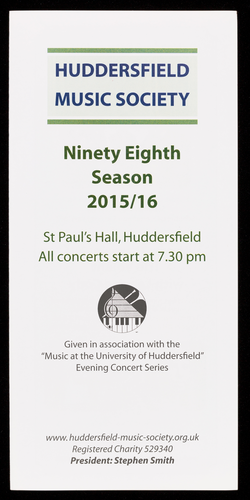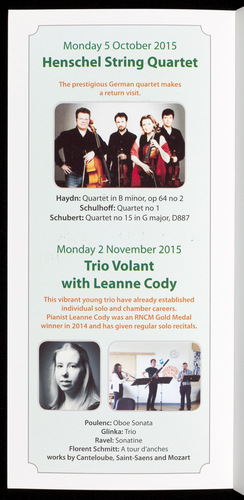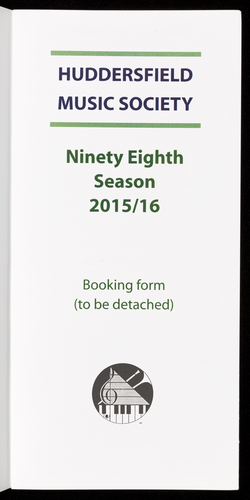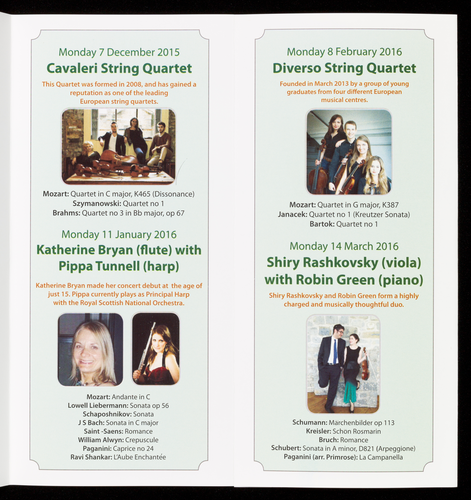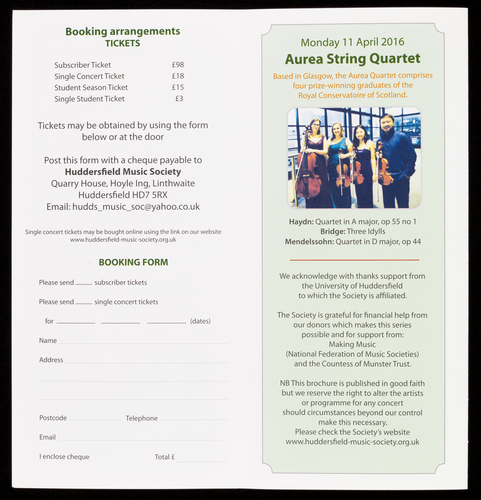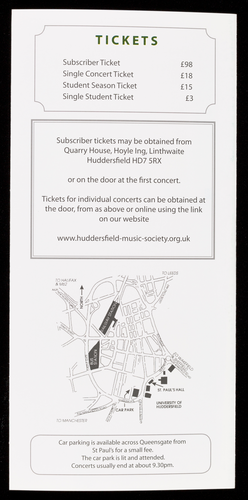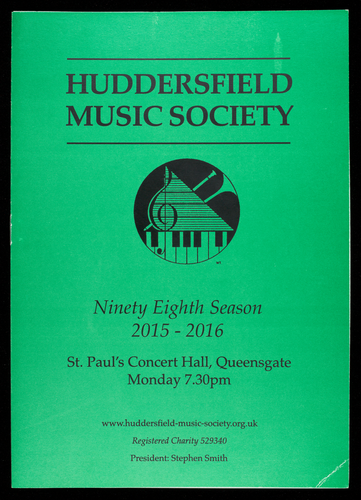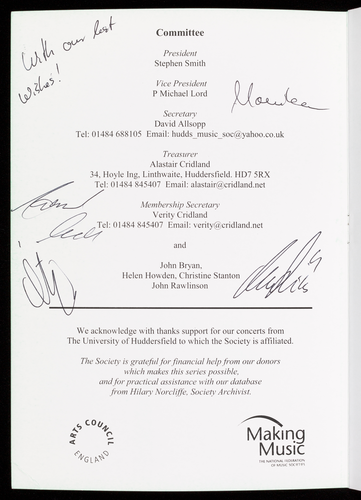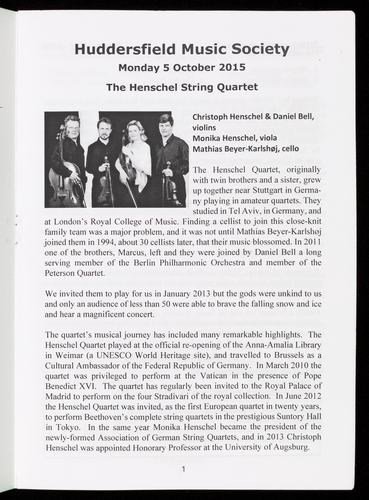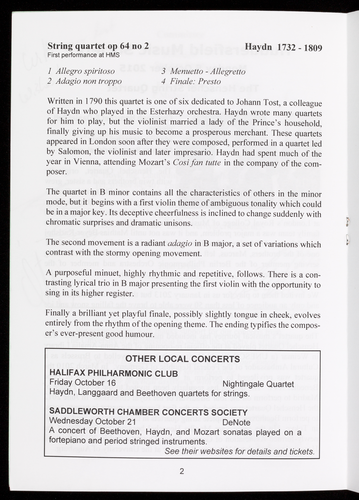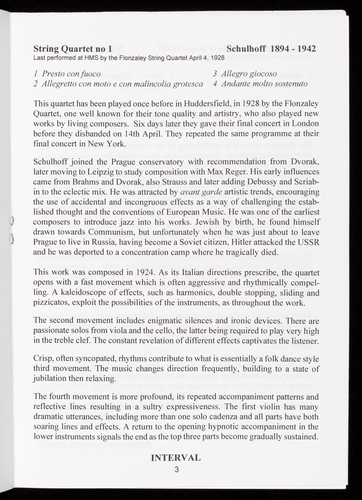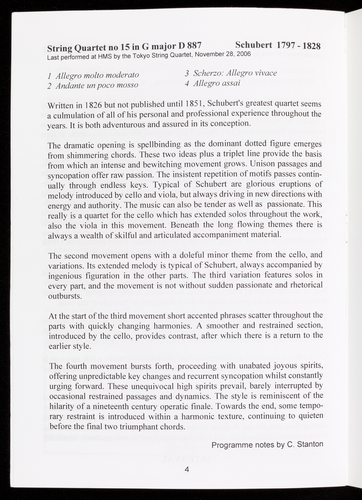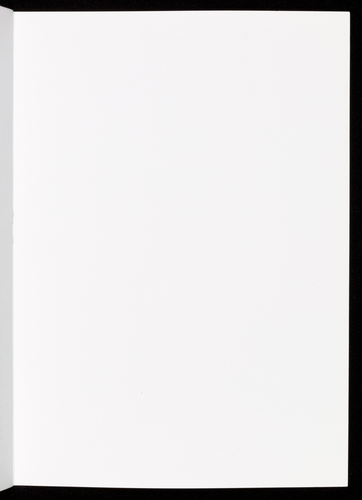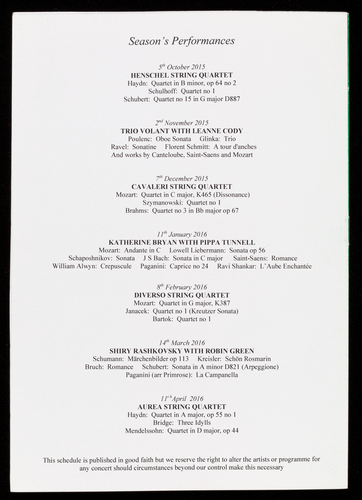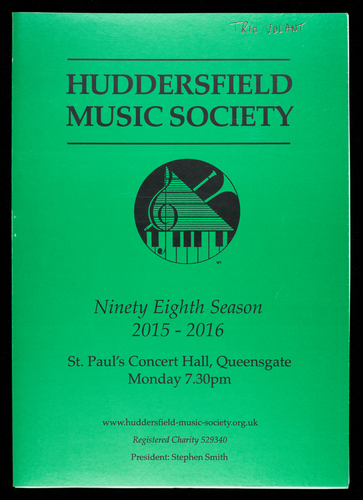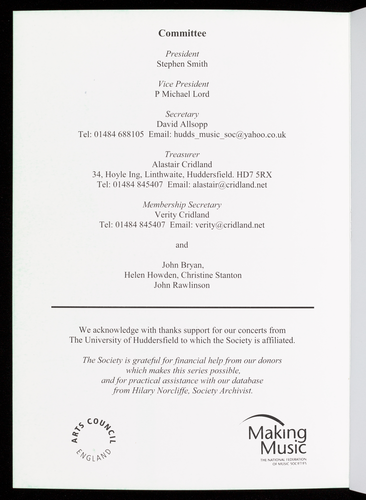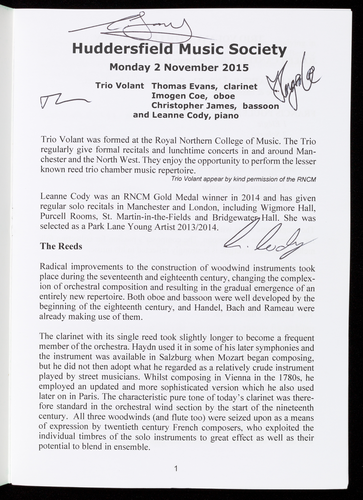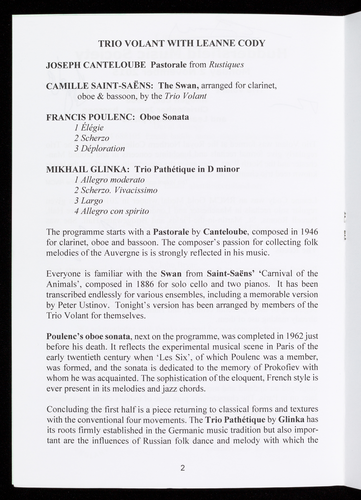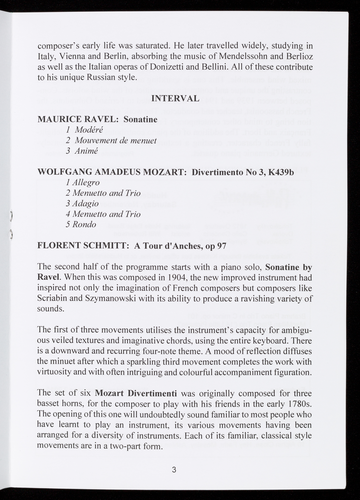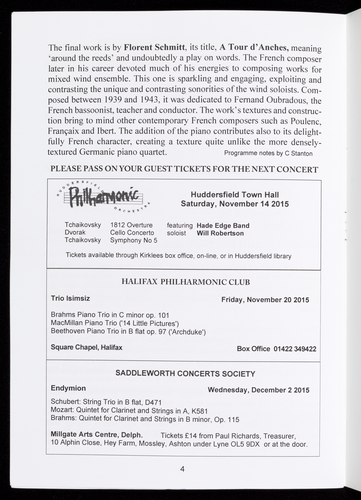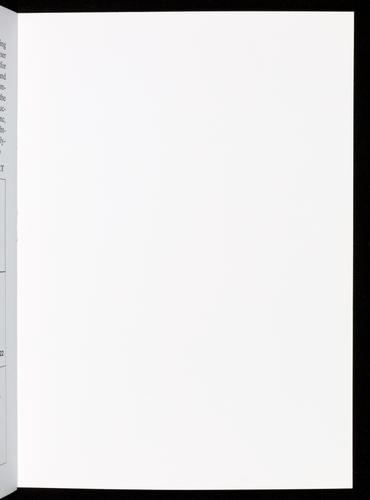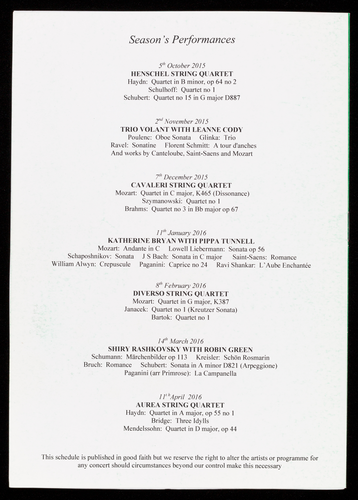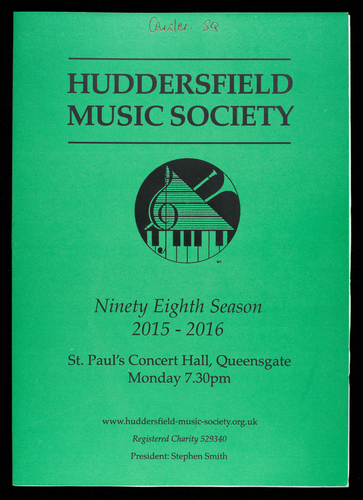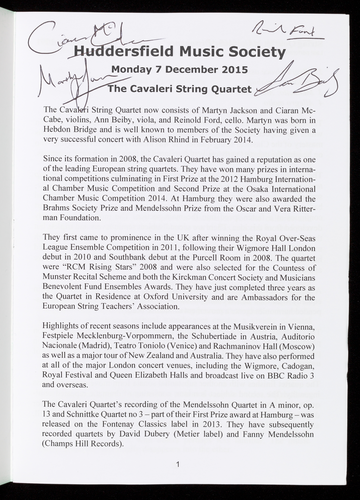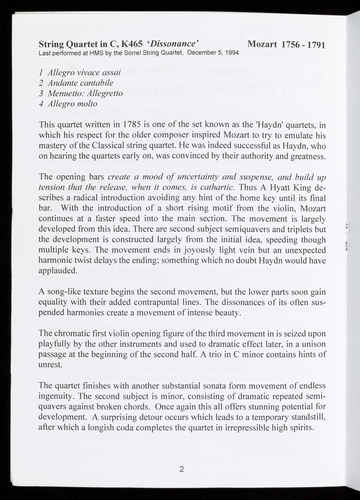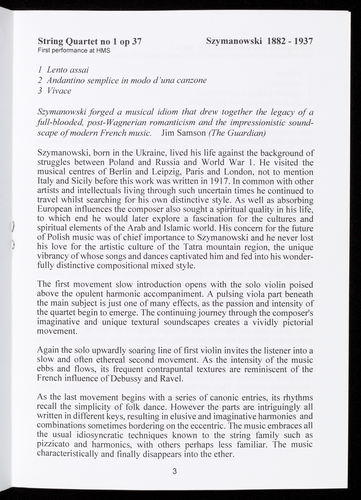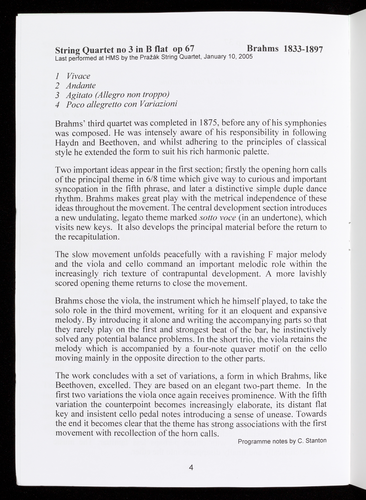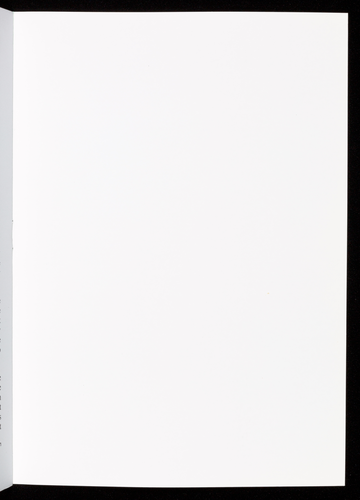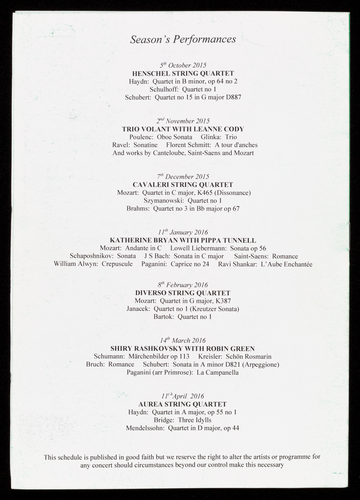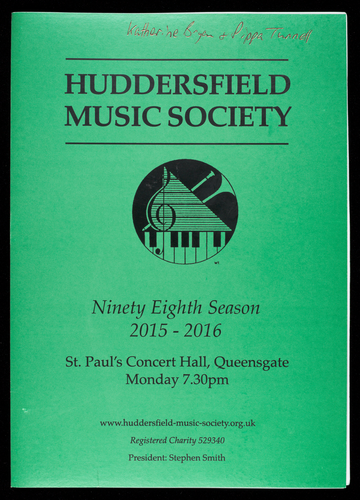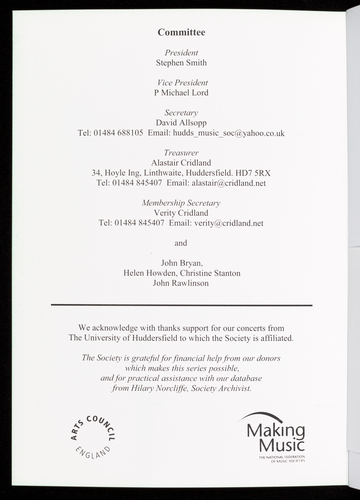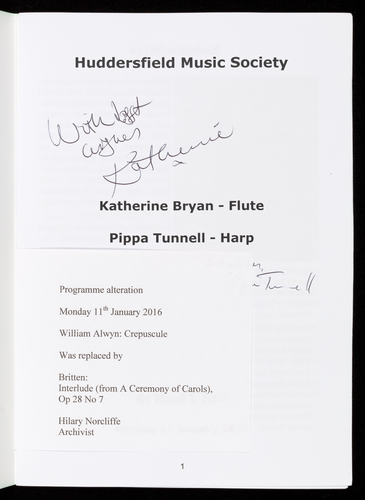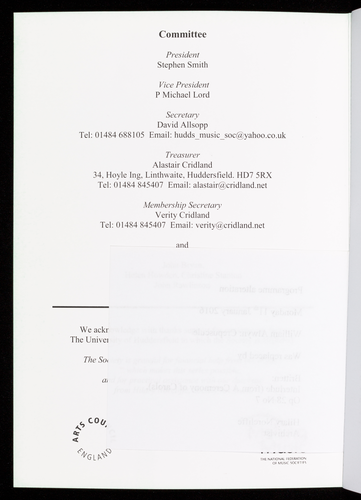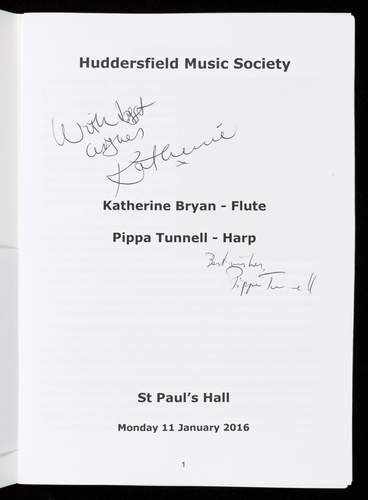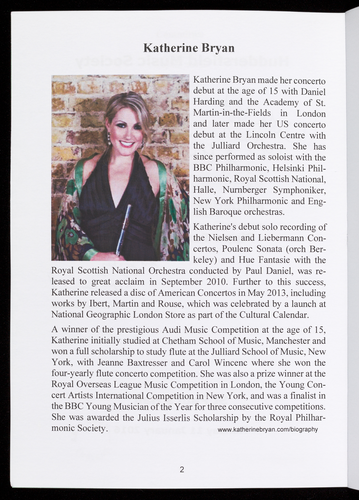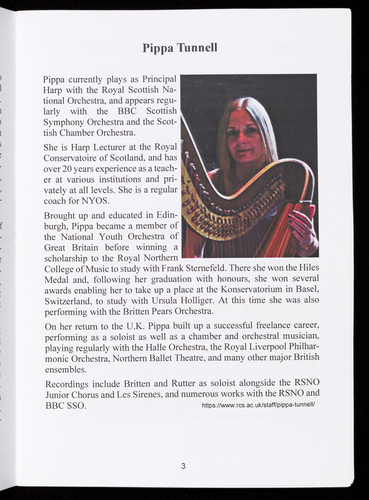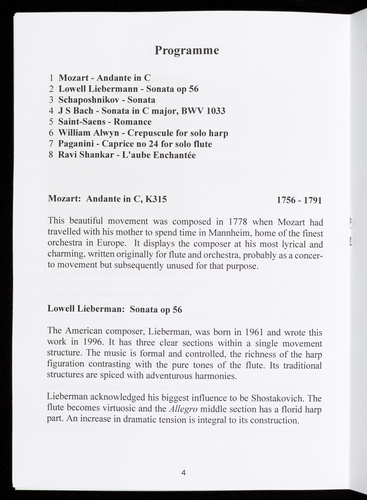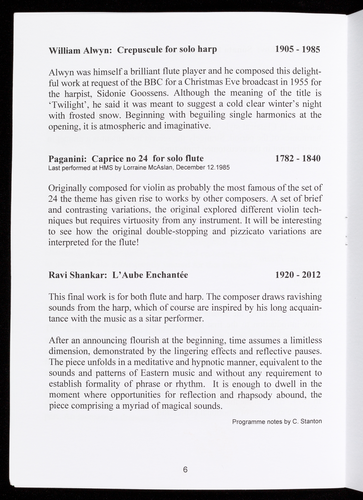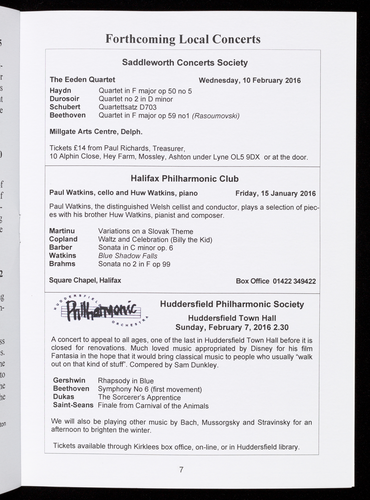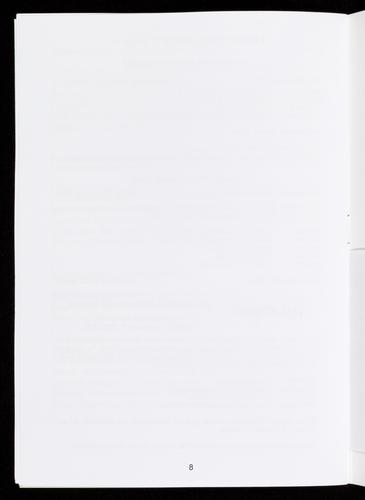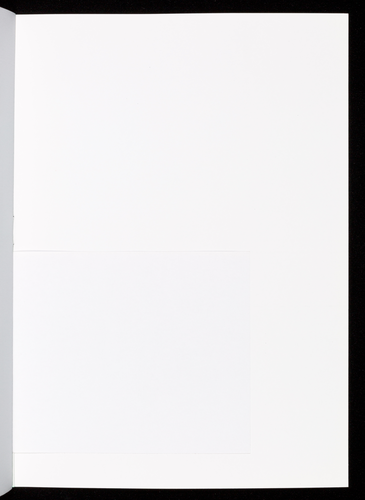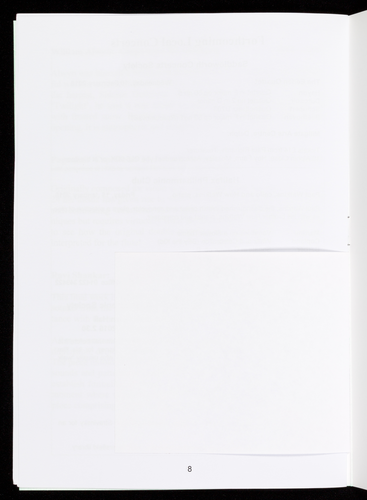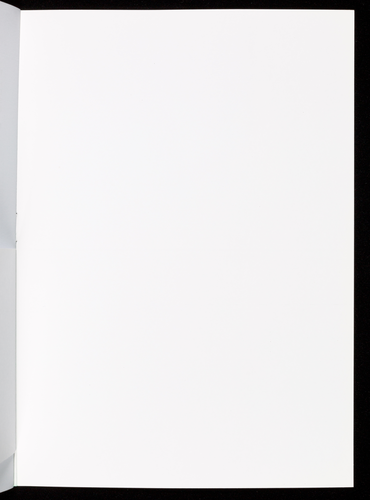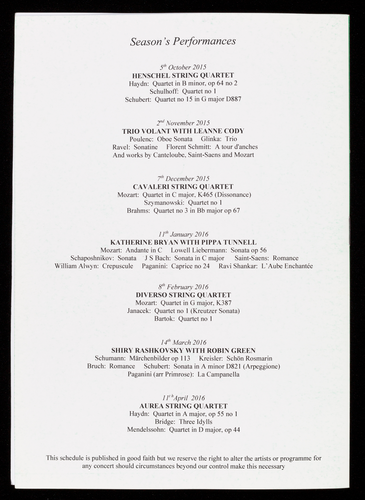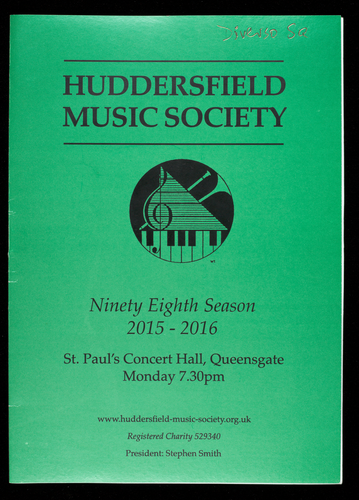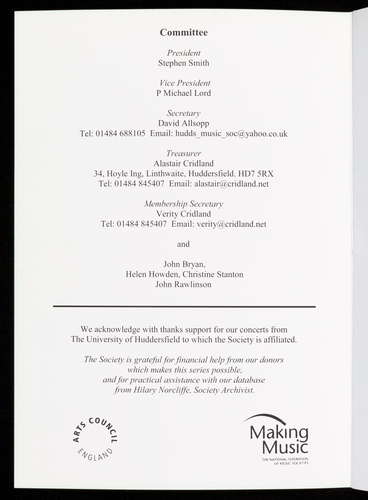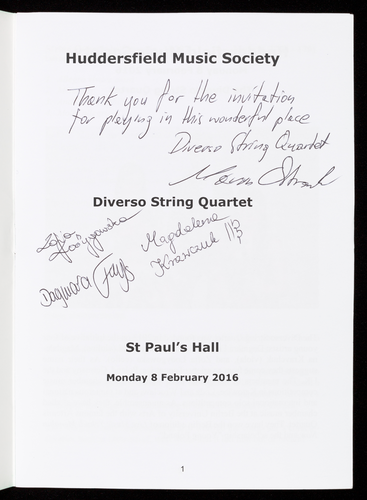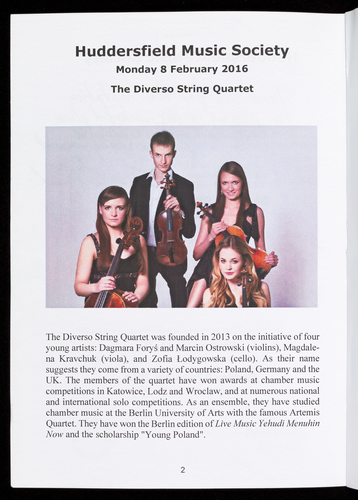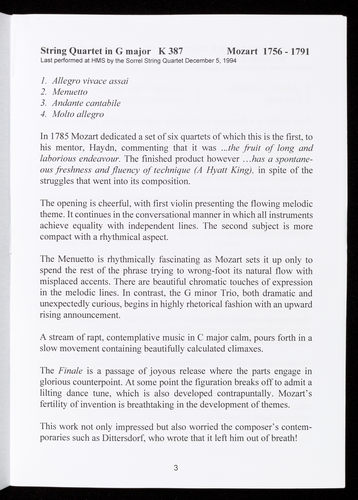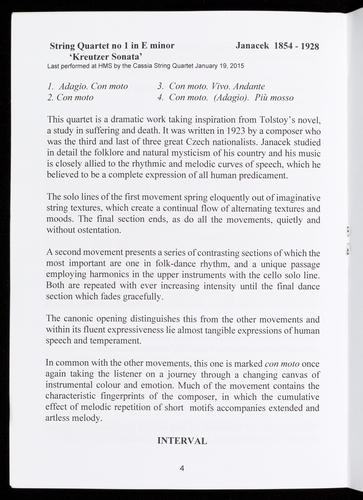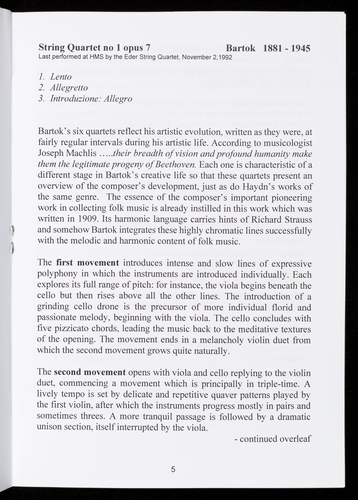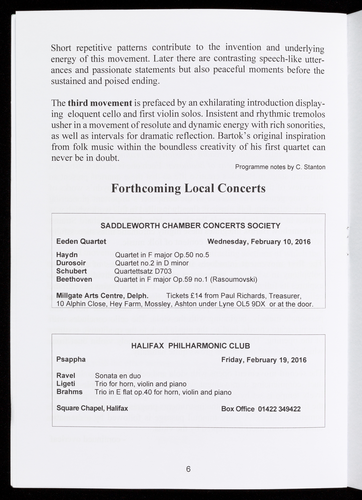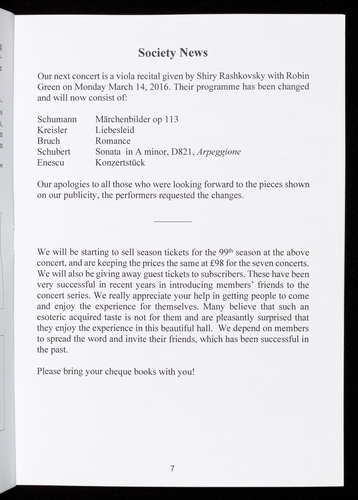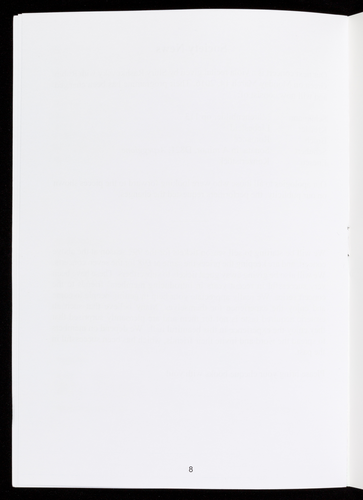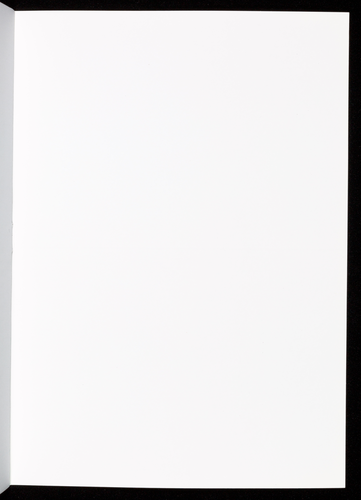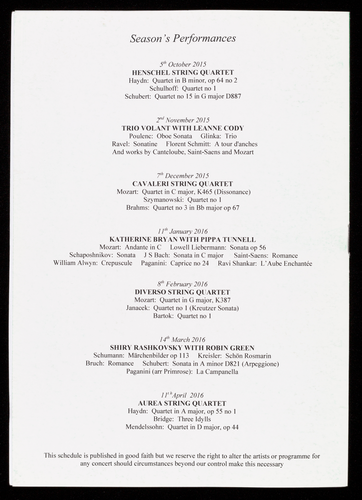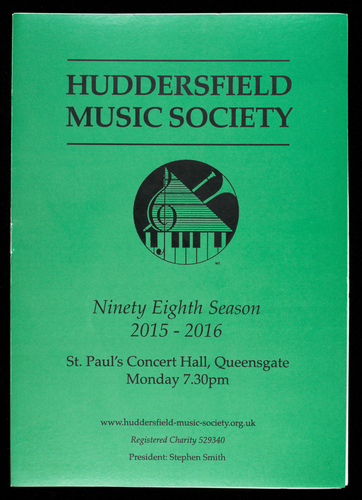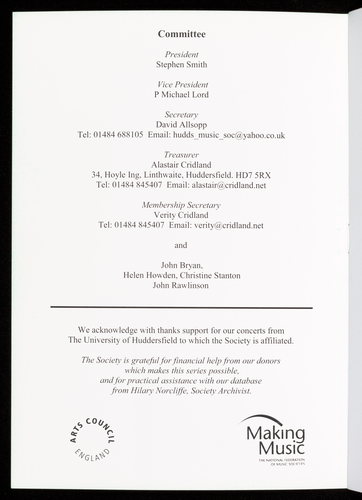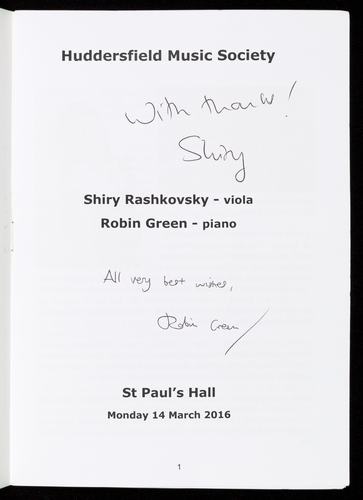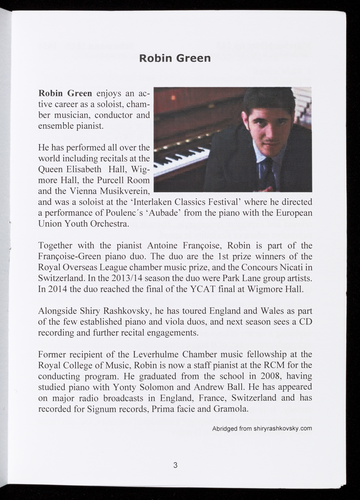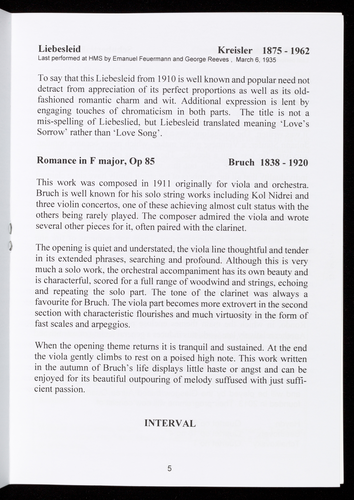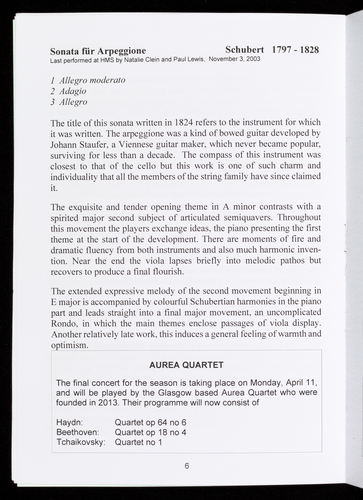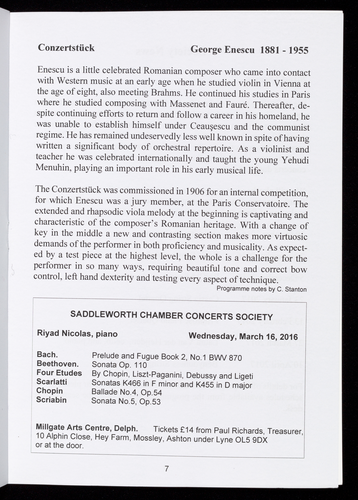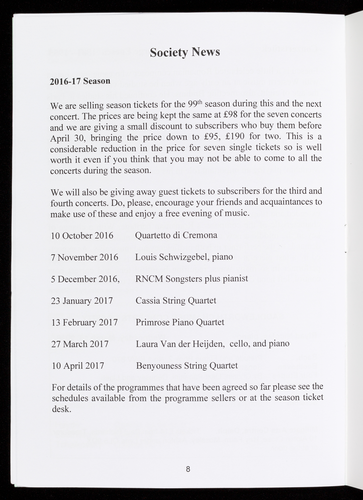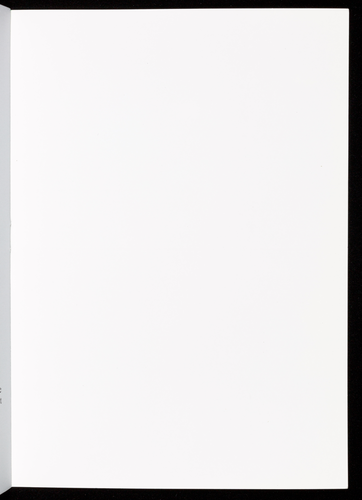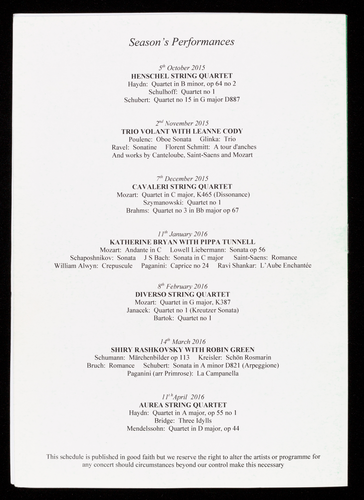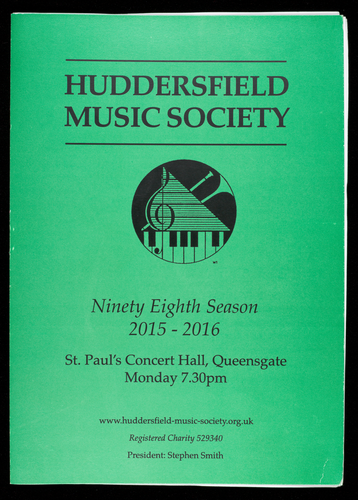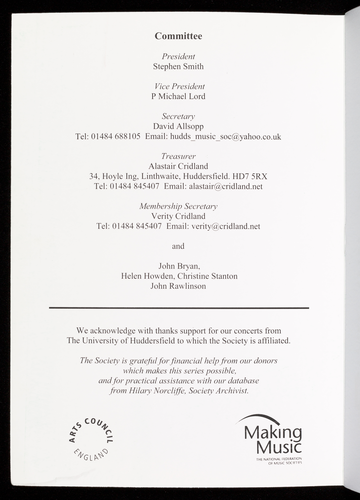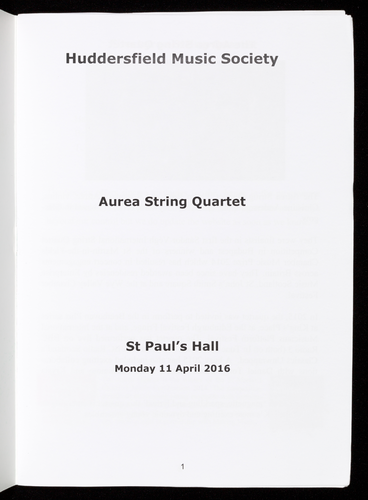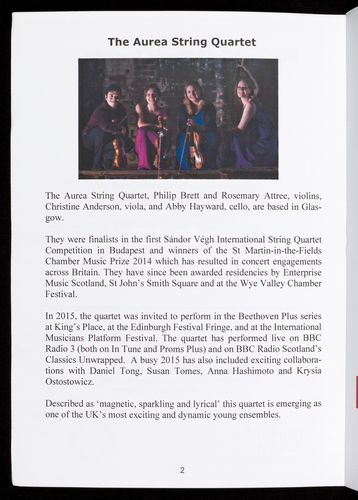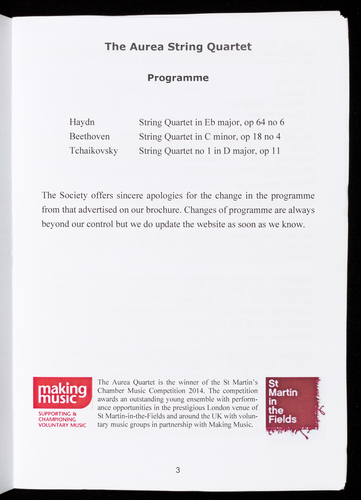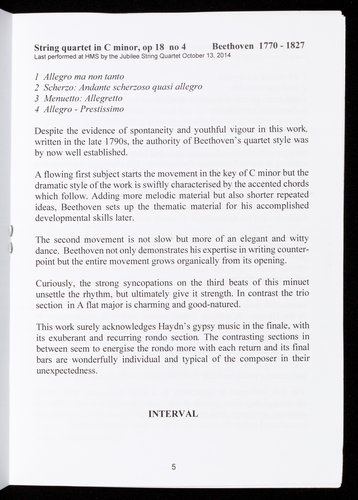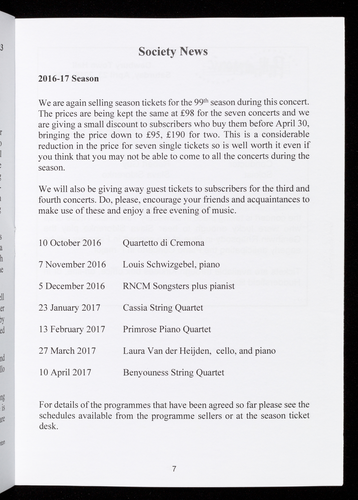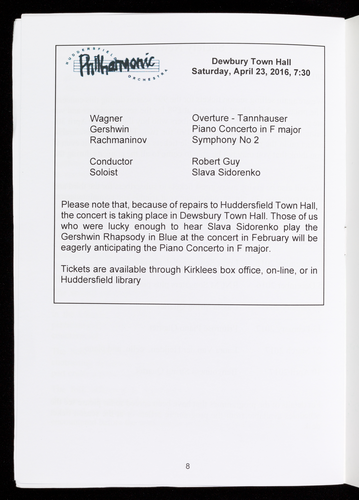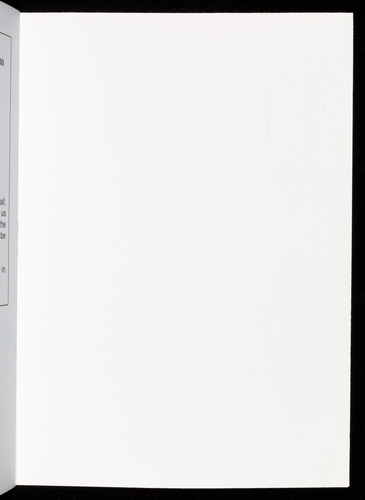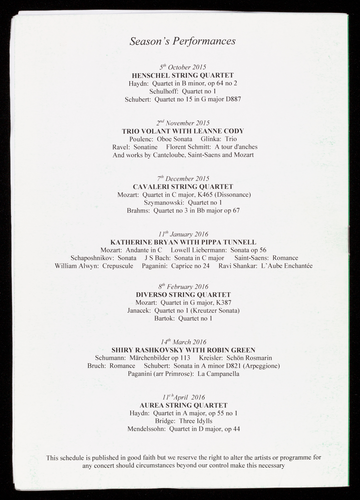Ocr'd Text:
HUDDERSFIELD
MUSIC SOCIETY
Ninety Eighth
Season
2015/16
St Paul's Hall, Huddersfield
All concerts start at 7.30 pm
448
WT
Given in association with the
"Music at the University of Huddersfield"
Evening Concert Series
www.huddersfield-music-society.org.uk
Registered Charity 529340
President: Stephen Smith
Ocr'd Text:
Monday 5 October 2015
Henschel String Quartet
The prestigious German quartet makes
a return visit.
Haydn: Quartet in B minor, op 64 no 2
Schulhoff: Quartet no 1
Schubert: Quartet no 15 in G major, D887
Monday 2 November 2015
Trio Volant
with Leanne Cody
This vibrant young trio have already established
individual solo and chamber careers.
Pianist Leanne Cody was an RNCM Gold Medal
winner in 2014 and has given regular solo recitals.
MATE
Poulenc: Oboe Sonata
Glinka: Trio
Ravel: Sonatine
Florent Schmitt: A tour d'anches
works by Canteloube, Saint-Saens and Mozart
Ocr'd Text:
HUDDERSFIELD
MUSIC SOCIETY
Ninety Eighth
Season
2015/16
Booking form
(to be detached)
WT
Ocr'd Text:
Monday 7 December 2015
Cavaleri String Quartet
This Quartet was formed in 2008, and has gained a
reputation as one of the leading
European string quartets.
Mozart: Quartet in C major, K465 (Dissonance)
Szymanowski: Quartet no 1
Brahms: Quartet no 3 in Bb major, op 67
Monday 11 January 2016
Katherine Bryan (flute) with
Pippa Tunnell (harp)
Katherine Bryan made her concert debut at the age of
just 15. Pippa currently plays as Principal Harp
with the Royal Scottish National Orchestra.
Mozart: Andante in C
Lowell Liebermann: Sonata op 56
Schaposhnikov: Sonata
JS Bach: Sonata in C major
Saint-Saens: Romance
William Alwyn: Crepuscule
Paganini: Caprice no 24
Ravi Shankar: L'Aube Enchantée
Monday 8 February 2016
Diverso String Quartet
Founded in March 2013 by a group of young
graduates from four different European
musical centres.
A
Mozart: Quartet in G major, K387
Janacek: Quartet no 1 (Kreutzer Sonata)
Bartok: Quartet no 1
Monday 14 March 2016
Shiry Rashkovsky (viola)
with Robin Green (piano)
Shiry Rashkovsky and Robin Green form a highly
charged and musically thoughtful duo.
Schumann: Märchenbilder op 113
Kreisler: Schön Rosmarin
Bruch: Romance
Schubert: Sonata in A minor, D821 (Arpeggione)
Paganini (arr. Primrose): La Campanella
Ocr'd Text:
Subscriber Ticket
Single Concert Ticket
Student Season Ticket
Single Student Ticket
Booking arrangements
Tickets may be obtained by using the form
below or at the door
Post this form with a cheque payable to
Huddersfield Music Society
Quarry House, Hoyle Ing, Linthwaite
Huddersfield HD7 5RX
Email: hudds_music_soc@yahoo.co.uk
for
Single concert tickets may be bought online using the link on our website
www.huddersfield-music-society.org.uk
TICKETS
Please send ............ subscriber tickets
Name
Please send ............ single concert tickets
Address
Postcode
Email
BOOKING FORM
I enclose cheque
£98
£18
£15
£3
Telephone
.........
Total £
(dates)
Monday 11 April 2016
Aurea String Quartet
Based in Glasgow, the Aurea Quartet comprises
four prize-winning graduates of the
Royal Conservatoire of Scotland.
tett
Haydn: Quartet in A major, op 55 no 1
Bridge: Three Idylls
Mendelssohn: Quartet in D major, op 44
We acknowledge with thanks support from
the University of Huddersfield
to which the Society is affiliated.
The Society is grateful for financial help from
our donors which makes this series
possible and for support from:
Making Music
(National Federation of Music Societies)
and the Countess of Munster Trust.
NB This brochure is published in good faith
but we reserve the right to alter the artists
or programme for any concert
should circumstances beyond our control
make this necessary.
Please check the Society's website
www.huddersfield-music-society.org.uk
Ocr'd Text:
Subscriber Ticket
Single Concert Ticket
Student Season Ticket
Single Student Ticket
TICKETS
Subscriber tickets may be obtained from
Quarry House, Hoyle Ing, Linthwaite
Huddersfield HD7 5RX
eeliக்
all
or on the door at the first concert.
Tickets for individual concerts can be obtained at
the door, from as above or online using the link
on our website
www.huddersfield-music-society.org.uk
HUMON
BUS
£98
£18
£15
RAILWAY STATION
1009
600
20080
00000
007
00U
CAR PARK
£3
ST. PAUL'S HALL
TO WAKEFIELD
UNIVERSITY OF
HUDDERSFIELD
The car park is lit and attended.
Concerts usually end at about 9.30pm.
Car parking is available across Queensgate from
St Paul's for a small fee.
A
Ocr'd Text:
HUDDERSFIELD
MUSIC SOCIETY
WT.
Ninety Eighth Season
2015-2016
St. Paul's Concert Hall, Queensgate
Monday 7.30pm
www.huddersfield-music-society.org.uk
Registered Charity 529340
President: Stephen Smith
Ocr'd Text:
With
تھائی لھا
our lest
fin
ceed
Committee
Secretary
David Allsopp
Tel: 01484 688105 Email: hudds_music_soc@yahoo.co.uk
ARTS
President
Stephen Smith
Vice President
P Michael Lord
Treasurer
Alastair Cridland
34, Hoyle Ing, Linthwaite, Huddersfield. HD7 5RX
Tel: 01484 845407 Email: alastair@cridland.net
COUNCIL
ENGLAND
Maula
Membership Secretary
Verity Cridland
Tel: 01484 845407 Email: verity@cridland.net
and
John Bryan,
Helen Howden, Christine Stanton
John Rawlinson
We acknowledge with thanks support for our concerts from
The University of Huddersfield to which the Society is affiliated.
The Society is grateful for financial help from our donors
which makes this series possible,
and for practical assistance with our database
from Hilary Norcliffe, Society Archivist.
Kils
Making
Music
THE NATIONAL FEDERATION
OF MUSIC SOCIETIES
Ocr'd Text:
Huddersfield Music Society
Monday 5 October 2015
The Henschel String Quartet
Christoph Henschel & Daniel Bell,
violins
Monika Henschel, viola
Mathias Beyer-Karlshøj, cello
The Henschel Quartet, originally
with twin brothers and a sister, grew
up together near Stuttgart in Germa-
ny playing in amateur quartets. They
studied in Tel Aviv, in Germany, and
at London's Royal College of Music. Finding a cellist to join this close-knit
family team was a major problem, and it was not until Mathias Beyer-Karlshøj
joined them in 1994, about 30 cellists later, that their music blossomed. In 2011
one of the brothers, Marcus, left and they were joined by Daniel Bell a long
serving member of the Berlin Philharmonic Orchestra and member of the
Peterson Quartet.
We invited them to play for us in January 2013 but the gods were unkind to us
and only an audience of less than 50 were able to brave the falling snow and ice
and hear a magnificent concert.
1
The quartet's musical journey has included many remarkable highlights. The
Henschel Quartet played at the official re-opening of the Anna-Amalia Library
in Weimar (a UNESCO World Heritage site), and travelled to Brussels as a
Cultural Ambassador of the Federal Republic of Germany. In March 2010 the
quartet was privileged to perform at the Vatican in the presence of Pope
Benedict XVI. The quartet has regularly been invited to the Royal Palace of
Madrid to perform on the four Stradivari of the royal collection. In June 2012
the Henschel Quartet was invited, as the first European quartet in twenty years,
to perform Beethoven's complete string quartets in the prestigious Suntory Hall
in Tokyo. In the same year Monika Henschel became the president of the
newly-formed Association of German String Quartets, and in 2013 Christoph
Henschel was appointed Honorary Professor at the University of Augsburg.
Ocr'd Text:
String quartet op 64 no 2
First performance at HMS
1 Allegro spiritoso
2 Adagio non troppo
plenar Haydn 1732 - 1809
3 Menuetto - Allegretto
4 Finale: Presto
Written in 1790 this quartet is one of six dedicated to Johann Tost, a colleague
of Haydn who played in the Esterhazy orchestra. Haydn wrote many quartets
for him to play, but the violinist married a lady of the Prince's household,
finally giving up his music to become a prosperous merchant. These quartets
appeared in London soon after they were composed, performed in a quartet led
by Salomon, the violinist and later impresario. Haydn had spent much of the
year in Vienna, attending Mozart's Cosi fan tutte in the company of the com-
poser.
The quartet in B minor contains all the characteristics of others in the minor
mode, but it begins with a first violin theme of ambiguous tonality which could
be in a major key. Its deceptive cheerfulness is inclined to change suddenly with
chromatic surprises and dramatic unisons.
The second movement is a radiant adagio in B major, a set of variations which
contrast with the stormy opening movement.
A purposeful minuet, highly rhythmic and repetitive, follows. There is a con-
trasting lyrical trio in B major presenting the first violin with the opportunity to
sing in its higher register.
Finally a brilliant yet playful finale, possibly slightly tongue in cheek, evolves
entirely from the rhythm of the opening theme. The ending typifies the compos-
er's ever-present good humour.
OTHER LOCAL CONCERTS
HALIFAX PHILHARMONIC CLUB
Friday October 16
Haydn, Langgaard and Beethoven quartets for strings.
2
Nightingale Quartet
SADDLEWORTH CHAMBER CONCERTS SOCIETY
Wednesday October 21
DeNote
A concert of Beethoven, Haydn, and Mozart sonatas played on a
fortepiano and period stringed instruments.
See their websites for details and tickets.
Ocr'd Text:
>
(
String Quartet no 1
Last performed at HMS by the Flonzaley String Quartet April 4, 1928
T88 (sojam Schulhoff 1894 - 1942
1 Presto con fuoco
2 Allegretto con moto e con malincolia grotesca
3 Allegro giocoso
4 Andante molto sostenuto
This quartet has been played once before in Huddersfield, in 1928 by the Flonzaley
Quartet, one well known for their tone quality and artistry, who also played new
works by living composers. Six days later they gave their final concert in London
before they disbanded on 14th April. They repeated the same programme at their
final concert in New York.
Schulhoff joined the Prague conservatory with recommendation from Dvorak,
later moving to Leipzig to study composition with Max Reger. His early influences
came from Brahms and Dvorak, also Strauss and later adding Debussy and Scriab-
in to the eclectic mix. He was attracted by avant garde artistic trends, encouraging
the use of accidental and incongruous effects as a way of challenging the estab-
lished thought and the conventions of European Music. He was one of the earliest
composers to introduce jazz into his works. Jewish by birth, he found himself
drawn towards Communism, but unfortunately when he was just about to leave
Prague to live in Russia, having become a Soviet citizen, Hitler attacked the USSR
and he was deported to a concentration camp where he tragically died.
This work was composed in 1924. As its Italian directions prescribe, the quartet
opens with a fast movement which is often aggressive and rhythmically compel-
ling. A kaleidoscope of effects, such as harmonics, double stopping, sliding and
pizzicatos, exploit the possibilities of the instruments, as throughout the work.
The second movement includes enigmatic silences and ironic devices. There are
passionate solos from viola and the cello, the latter being required to play very high
in the treble clef. The constant revelation of different effects captivates the listener.
Crisp, often syncopated, rhythms contribute to what is essentially a folk dance style
third movement. The music changes direction frequently, building to a state of
jubilation then relaxing.
The fourth movement is more profound, its repeated accompaniment patterns and
reflective lines resulting in a sultry expressiveness. The first violin has many
dramatic utterances, including more than one solo cadenza and all parts have both
soaring lines and effects. A return to the opening hypnotic accompaniment in the
lower instruments signals the end as the top three parts become gradually sustained.
INTERVAL
3
als
Ocr'd Text:
String Quartet no 15 in G major D 887
Last performed at HMS by the Tokyo String Quartet, November 28, 2006
1 Allegro molto moderato
2 Andante un poco mosso
Schubert 1797-1828
3 Scherzo: Allegro vivace
4 Allegro assai
Written in 1826 but not published until 1851, Schubert's greatest quartet seems
a culmulation of all of his personal and professional experience throughout the
years. It is both adventurous and assured in its conception.
The dramatic opening is spellbinding as the dominant dotted figure emerges
from shimmering chords. These two ideas plus a triplet line provide the basis
from which an intense and bewitching movement grows. Unison passages and
syncopation offer raw passion. The insistent repetition of motifs passes contin-
ually through endless keys. Typical of Schubert are glorious eruptions of
melody introduced by cello and viola, but always driving in new directions with
energy and authority. The music can also be tender as well as passionate. This
really is a quartet for the cello which has extended solos throughout the work,
also the viola in this movement. Beneath the long flowing themes there is
always a wealth of skilful and articulated accompaniment material.
The second movement opens with a doleful minor theme from the cello, and
variations. Its extended melody is typical of Schubert, always accompanied by
ingenious figuration in the other parts. The third variation features solos in
every part, and the movement is not without sudden passionate and rhetorical
outbursts.
At the start of the third movement short accented phrases scatter throughout the
parts with quickly changing harmonies. A smoother and restrained section,
introduced by the cello, provides contrast, after which there is a return to the
earlier style.
The fourth movement bursts forth, proceeding with unabated joyous spirits,
offering unpredictable key changes and recurrent syncopation whilst constantly
urging forward. These unequivocal high spirits prevail, barely interrupted by
occasional restrained passages and dynamics. The style is reminiscent of the
hilarity of a nineteenth century operatic finale. Towards the end, some tempo-
rary restraint is introduced within a harmonic texture, continuing to quieten
before the final two triumphant chords.
4
Programme notes by C. Stanton
Ocr'd Text:
Season's Performances
5th October 2015
HENSCHEL STRING QUARTET
Haydn: Quartet in B minor, op 64 no 2
Schulhoff: Quartet no 1
Schubert: Quartet no 15 in G major D887
2nd November 2015
TRIO VOLANT WITH LEANNE CODY
Poulenc: Oboe Sonata Glinka: Trio
Ravel: Sonatine Florent Schmitt: A tour d'anches
And works by Canteloube, Saint-Saens and Mozart
7th December 2015
CAVALERI STRING QUARTET
Mozart: Quartet in C major, K465 (Dissonance)
Szymanowski: Quartet no 1
Brahms: Quartet no 3 in Bb major op 67
11th January 2016
KATHERINE BRYAN WITH PIPPA TUNNELL
Mozart: Andante in C Lowell Liebermann: Sonata op 56
Schaposhnikov: Sonata JS Bach: Sonata in C major Saint-Saens: Romance
William Alwyn: Crepuscule Paganini: Caprice no 24 Ravi Shankar: L'Aube Enchantée
8th February 2016
DIVERSO STRING QUARTET
Mozart: Quartet in G major, K387
Janacek: Quartet no 1 (Kreutzer Sonata)
Bartok: Quartet no 1
14th March 2016
SHIRY RASHKOVSKY WITH ROBIN GREEN
Schumann: Märchenbilder op 113 Kreisler: Schön Rosmarin
Bruch: Romance Schubert: Sonata in A minor D821 (Arpeggione)
Paganini (arr Primrose): La Campanella
11th April 2016
AUREA STRING QUARTET
Haydn: Quartet in A major, op 55 no 1
Bridge: Three Idylls
Mendelssohn: Quartet in D major, op 44
This schedule is published in good faith but we reserve the right to alter the artists or programme for
any concert should circumstances beyond our control make this necessary
Ocr'd Text:
TRIO. VOLANT.
HUDDERSFIELD
MUSIC SOCIETY
WT.
Ninety Eighth Season
2015 - 2016
St. Paul's Concert Hall, Queensgate
Monday 7.30pm
www.huddersfield-music-society.org.uk
Registered Charity 529340
President: Stephen Smith
Ocr'd Text:
Committee
Secretary
David Allsopp
Tel: 01484 688105 Email: hudds_music_soc@yahoo.co.uk
ARTS
President
Stephen Smith
Vice President
P Michael Lord
Alastair Cridland
34, Hoyle Ing, Linthwaite, Huddersfield. HD7 5RX
Tel: 01484 845407 Email: alastair@cridland.net
Treasurer
Membership Secretary
Verity Cridland.
Tel: 01484 845407 Email: verity@cridland.net
COUNCIL
ENGLAND
We acknowledge with thanks support for our concerts from
The University of Huddersfield to which the Society is affiliated.
and
John Bryan,
Helen Howden, Christine Stanton
John Rawlinson
The Society is grateful for financial help from our donors
which makes this series possible,
and for practical assistance with our database
from Hilary Norcliffe, Society Archivist.
Making
Music
THE NATIONAL FEDERATION
OF MUSIC SOCIETIES
Ocr'd Text:
يسع
Huddersfield Music Society
Monday 2 November 2015
Trio Volant Thomas Evans, clarinet
Imogen Coe, oboe
The Reeds
Christopher James, bassoon
and Leanne Cody, piano
Trio Volant was formed at the Royal Northern College of Music. The Trio
regularly give formal recitals and lunchtime concerts in and around Man-
chester and the North West. They enjoy the opportunity to perform the lesser
known reed trio chamber music repertoire.
Trio Volant appear by kind permission of the RNCM
Lagale
Leanne Cody was an RNCM Gold Medal winner in 2014 and has given
regular solo recitals in Manchester and London, including Wigmore Hall,
Purcell Rooms, St. Martin-in-the-Fields and Bridgewater Hall. She was
selected as a Park Lane Young Artist 2013/2014.
h. Judy
Radical improvements to the construction of woodwind instruments took
place during the seventeenth and eighteenth century, changing the complex-
ion of orchestral composition and resulting in the gradual emergence of an
entirely new repertoire. Both oboe and bassoon were well developed by the
beginning of the eighteenth century, and Handel, Bach and Rameau were
already making use of them.
The clarinet with its single reed took slightly longer to become a frequent
member of the orchestra. Haydn used it in some of his later symphonies and
the instrument was available in Salzburg when Mozart began composing,
but he did not then adopt what he regarded as a relatively crude instrument
played by street musicians. Whilst composing in Vienna in the 1780s, he
employed an updated and more sophisticated version which he also used
later on in Paris. The characteristic pure tone of today's clarinet was there-
fore standard in the orchestral wind section by the start of the nineteenth
century. All three woodwinds (and flute too) were seized upon as a means
of expression by twentieth century French composers, who exploited the
individual timbres of the solo instruments to great effect as well as their
potential to blend in ensemble.
1
Ocr'd Text:
TRIO VOLANT WITH LEANNE CODY
JOSEPH CANTELOUBE Pastorale from Rustiques
CAMILLE SAINT-SAËNS: The Swan, arranged for clarinet,
oboe & bassoon, by the Trio Volant
FRANCIS POULENC: Oboe Sonata
1 Élégie
2 Scherzo
3 Déploration
MIKHAIL GLINKA: Trio Pathétique in D minor
1 Allegro moderato
2 Scherzo. Vivacissimo
3 Largo
4 Allegro con spirito
The programme starts with a Pastorale by Canteloube, composed in 1946
for clarinet, oboe and bassoon. The composer's passion for collecting folk
melodies of the Auvergne is is strongly reflected in his music.
Everyone is familiar with the Swan from Saint-Saëns' 'Carnival of the
Animals', composed in 1886 for solo cello and two pianos. It has been
transcribed endlessly for various ensembles, including a memorable version.
by Peter Ustinov. Tonight's version has been arranged by members of the
Trio Volant for themselves.
Poulenc's oboe sonata, next on the programme, was completed in 1962 just
before his death. It reflects the experimental musical scene in Paris of the
early twentieth century when 'Les Six', of which Poulenc was a member,
was formed, and the sonata is dedicated to the memory of Prokofiev with
whom he was acquainted. The sophistication of the eloquent, French style is
ever present in its melodies and jazz chords.
Concluding the first half is a piece returning to classical forms and textures
with the conventional four movements. The Trio Pathétique by Glinka has
its roots firmly established in the Germanic music tradition but also impor-
tant are the influences of Russian folk dance and melody with which the
2
Ocr'd Text:
}
3
composer's early life was saturated. He later travelled widely, studying in
Italy, Vienna and Berlin, absorbing the music of Mendelssohn and Berlioz
as well as the Italian operas of Donizetti and Bellini. All of these contribute
to his unique Russian style.
INTERVAL
MAURICE RAVEL: Sonatine
1 Modéré
2 Mouvement de menuet
3 Animé
WOLFGANG AMADEUS MOZART: Divertimento No 3, K439b
1 Allegro
2 Menuetto and Trio
3 Adagio
4 Menuetto and Trio
5 Rondo
FLORENT SCHMITT: A Tour d'Anches, op 97
The second half of the programme starts with a piano solo, Sonatine by
Ravel. When this was composed in 1904, the new improved instrument had
inspired not only the imagination of French composers but composers like
Scriabin and Szymanowski with its ability to produce a ravishing variety of
sounds.
The first of three movements utilises the instrument's capacity for ambigu-
ous veiled textures and imaginative chords, using the entire keyboard. There
is a downward and recurring four-note theme. A mood of reflection diffuses
the minuet after which a sparkling third movement completes the work with
virtuosity and with often intriguing and colourful accompaniment figuration.
The set of six Mozart Divertimenti was originally composed for three
basset horns, for the composer to play with his friends in the early 1780s.
The opening of this one will undoubtedly sound familiar to most people who
have learnt to play an instrument, its various movements having been
arranged for a diversity of instruments. Each of its familiar, classical style
movements are in a two-part form.
3
Ocr'd Text:
The final work is by Florent Schmitt, its title, A Tour d'Anches, meaning
'around the reeds' and undoubtedly a play on words. The French composer
later in his career devoted much of his energies to composing works for
mixed wind ensemble. This one is sparkling and engaging, exploiting and
contrasting the unique and contrasting sonorities of the wind soloists. Com-
posed between 1939 and 1943, it was dedicated to Fernand Oubradous, the
French bassoonist, teacher and conductor. The work's textures and construc-
tion bring to mind other contemporary French composers such as Poulenc,
Françaix and Ibert. The addition of the piano contributes also to its delight-
fully French character, creating a texture quite unlike the more densely-
textured Germanic piano quartet.
Programme notes by C Stanton
PLEASE PASS ON YOUR GUEST TICKETS FOR THE NEXT CONCERT
HUD
Philharmonic
ORCHEST
Trio Isimsiz
Huddersfield Town Hall
Saturday, November 14 2015
Tchaikovsky
Dvorak
1812 Overture
Cello Concerto
Tchaikovsky Symphony No 5
Tickets available through Kirklees box office, on-line, or in Huddersfield library
featuring Hade Edge Band
soloist Will Robertson
HALIFAX PHILHARMONIC CLUB
Brahms Piano Trio in C minor op. 101
MacMillan Piano Trio ('14 Little Pictures')
Beethoven Piano Trio in B flat op. 97 ('Archduke')
Square Chapel, Halifax
Friday, November 20 2015
Box Office 01422 349422
SADDLEWORTH CONCERTS SOCIETY
Endymion
Schubert: String Trio in B flat, D471
Mozart: Quintet for Clarinet and Strings in A, K581
Brahms: Quintet for Clarinet and Strings in B minor, Op. 115
4
Wednesday, December 2 2015
Millgate Arts Centre, Delph.
Tickets £14 from Paul Richards, Treasurer,
10 Alphin Close, Hey Farm, Mossley, Ashton under Lyne OL5 9DX or at the door.
Ocr'd Text:
Sur
ᏗᏚ
for
and
-W
the
LIC-
anc,
ht-
ly-
I
سات
Ocr'd Text:
Season's Performances
5th October 2015
HENSCHEL STRING QUARTET
Haydn: Quartet in B minor, op 64 no 2
Schulhoff: Quartet no 1
Schubert: Quartet no 15 in G major D887
2nd November 2015
TRIO VOLANT WITH LEANNE CODY
Poulenc: Oboe Sonata Glinka: Trio
Ravel: Sonatine Florent Schmitt: A tour d'anches
And works by Canteloube, Saint-Saens and Mozart
7th December 2015
CAVALERI STRING QUARTET
Mozart: Quartet in C major, K465 (Dissonance)
Szymanowski: Quartet no 1
Brahms: Quartet no 3 in Bb major op 67
11th January 2016
KATHERINE BRYAN WITH PIPPA TUNNELL
Mozart: Andante in C Lowell Liebermann: Sonata op 56
Schaposhnikov: Sonata JS Bach: Sonata in C major
Saint-Saens: Romance
William Alwyn: Crepuscule Paganini: Caprice no 24 Ravi Shankar: L'Aube Enchantée
8th February 2016
DIVERSO STRING QUARTET
Mozart: Quartet in G major, K387
Janacek: Quartet no 1 (Kreutzer Sonata)
Bartok: Quartet no 1
14th March 2016
SHIRY RASHKOVSKY WITH ROBIN GREEN
Schumann: Märchenbilder op 113 Kreisler: Schön Rosmarin
Bruch: Romance Schubert: Sonata in A minor D821 (Arpeggione)
Paganini (arr Primrose): La Campanella
11th April 2016
AUREA STRING QUARTET
Haydn: Quartet in A major, op 55 no 1
Bridge: Three Idylls
Mendelssohn: Quartet in D major, op 44
This schedule is published in good faith but we reserve the right to alter the artists or programme for
any concert should circumstances beyond our control make this necessary
Ocr'd Text:
Caraler SQ
HUDDERSFIELD
MUSIC SOCIETY
WT.
Ninety Eighth Season
2015 - 2016
St. Paul's Concert Hall, Queensgate
Monday 7.30pm
www.huddersfield-music-society.org.uk
Registered Charity 529340
President: Stephen Smith
Ocr'd Text:
Committee
Secretary
David Allsopp
Tel: 01484 688105 Email: hudds_music_soc@yahoo.co.uk
ARTS
President
Stephen Smith
Vice President
P Michael Lord
Alastair Cridland
34, Hoyle Ing, Linthwaite, Huddersfield. HD7 5RX
Tel: 01484 845407 Email: alastair@cridland.net
Treasurer
Membership Secretary
Verity Cridland
Tel: 01484 845407 Email: verity@cridland.net
COUNCIL
ENGLAND
We acknowledge with thanks support for our concerts from
The University of Huddersfield to which the Society is affiliated.
and
John Bryan,
Helen Howden, Christine Stanton
John Rawlinson
The Society is grateful for financial help from our donors
which makes this series possible,
and for practical assistance with our database
from Hilary Norcliffe, Society Archivist.
Making
Music
THE NATIONAL FEDERATION
OF MUSIC SOCIETIES
Ocr'd Text:
Mil Font
MO
Huddersfield Music Society
Monday 7 December 2015
The Cavaleri String Quartet
сал
Maryl
JaBig
The Cavaleri String Quartet now consists of Martyn Jackson and Ciaran Mc-
Cabe, violins, Ann Beiby, viola, and Reinold Ford, cello. Martyn was born in
Hebdon Bridge and is well known to members of the Society having given a
very successful concert with Alison Rhind in February 2014.
Since its formation in 2008, the Cavaleri Quartet has gained a reputation as one
of the leading European string quartets. They have won many prizes in interna-
tional competitions culminating in First Prize at the 2012 Hamburg Internation-
al Chamber Music Competition and Second Prize at the Osaka International
Chamber Music Competition 2014. At Hamburg they were also awarded the
Brahms Society Prize and Mendelssohn Prize from the Oscar and Vera Ritter-
man Foundation.
They first came to prominence in the UK after winning the Royal Over-Seas
League Ensemble Competition in 2011, following their Wigmore Hall London
debut in 2010 and Southbank debut at the Purcell Room in 2008. The quartet
were "RCM Rising Stars" 2008 and were also selected for the Countess of
Munster Recital Scheme and both the Kirckman Concert Society and Musicians
Benevolent Fund Ensembles Awards. They have just completed three years as
the Quartet in Residence at Oxford University and are Ambassadors for the
European String Teachers' Association.
Highlights of recent seasons include appearances at the Musikverein in Vienna,
Festpiele Mecklenburg-Vorpommern, the Schubertiade in Austria, Auditorio
Nacionale (Madrid), Teatro Toniolo (Venice) and Rachmaninov Hall (Moscow)
as well as a major tour of New Zealand and Australia. They have also performed
at all of the major London concert venues, including the Wigmore, Cadogan,
Royal Festival and Queen Elizabeth Halls and broadcast live on BBC Radio 3
and overseas.
The Cavaleri Quartet's recording of the Mendelssohn Quartet in A minor, op.
13 and Schnittke Quartet no 3 - part of their First Prize award at Hamburg - was
released on the Fontenay Classics label in 2013. They have subsequently
recorded quartets by David Dubery (Metier label) and Fanny Mendelssohn
(Champs Hill Records).
1
Ocr'd Text:
String Quartet in C, K465 'Dissonance'
Last performed at HMS by the Sorrel String Quartet, December 5, 1994
1 Allegro vivace assai
2 Andante cantabile
3 Menuetto: Allegretto
4 Allegro molto
Mozart 1756-1791
This quartet written in 1785 is one of the set known as the 'Haydn' quartets, in
which his respect for the older composer inspired Mozart to try to emulate his
mastery of the Classical string quartet. He was indeed successful as Haydn, who
on hearing the quartets early on, was convinced by their authority and greatness.
The opening bars create a mood of uncertainty and suspense, and build up
tension that the release, when it comes, is cathartic. Thus A Hyatt King de-
scribes a radical introduction avoiding any hint of the home key until its final
bar. With the introduction of a short rising motif from the violin, Mozart
continues at a faster speed into the main section. The movement is largely
developed from this idea. There are second subject semiquavers and triplets but
the development is constructed largely from the initial idea, speeding though
multiple keys. The movement ends in joyously light vein but an unexpected
harmonic twist delays the ending; something which no doubt Haydn would have
applauded.
A song-like texture begins the second movement, but the lower parts soon gain
equality with their added contrapuntal lines. The dissonances of its often sus-
pended harmonies create a movement of intense beauty.
The chromatic first violin opening figure of the third movement in is seized upon
playfully by the other instruments and used to dramatic effect later, in a unison
passage at the beginning of the second half. A trio in C minor contains hints of
unrest.
The quartet finishes with another substantial sonata form movement of endless
ingenuity. The second subject is minor, consisting of dramatic repeated semi-
quavers against broken chords. Once again this all offers stunning potential for
development. A surprising detour occurs which leads to a temporary standstill,
after which a longish coda completes the quartet in irrepressible high spirits.
2
T
Ocr'd Text:
String Quartet no 1 op 37
First performance at HMS
Szymanowski 1882 - 1937
1 Lento assai
2 Andantino semplice in modo d'una canzone
3 Vivace
Szymanowski forged a musical idiom that drew together the legacy of a
full-blooded, post-Wagnerian romanticism and the impressionistic sound-
scape of modern French music. Jim Samson (The Guardian)
Szymanowski, born in the Ukraine, lived his life against the background of
struggles between Poland and Russia and World War 1. He visited the
musical centres of Berlin and Leipzig, Paris and London, not to mention
Italy and Sicily before this work was written in 1917. In common with other
artists and intellectuals living through such uncertain times he continued to
travel whilst searching for his own distinctive style. As well as absorbing
European influences the composer also sought a spiritual quality in his life,
to which end he would later explore a fascination for the cultures and
spiritual elements of the Arab and Islamic world. His concern for the future
of Polish music was of chief importance to Szymanowski and he never lost
his love for the artistic culture of the Tatra mountain region, the unique
vibrancy of whose songs and dances captivated him and fed into his wonder-
fully distinctive compositional mixed style.
)
The first movement slow introduction opens with the solo violin poised
above the opulent harmonic accompaniment. A pulsing viola part beneath
the main subject is just one of many effects, as the passion and intensity of
the quartet begin to emerge. The continuing journey through the composer's
imaginative and unique textural soundscapes creates a vividly pictorial
movement.
Again the solo upwardly soaring line of first violin invites the listener into a
slow and often ethereal second movement. As the intensity of the music
ebbs and flows, its frequent contrapuntal textures are reminiscent of the
French influence of Debussy and Ravel.
As the last movement begins with a series of canonic entries, its rhythms
recall the simplicity of folk dance. However the parts are intriguingly all
written in different keys, resulting in elusive and imaginative harmonies and
combinations sometimes bordering on the eccentric. The music embraces all
the usual idiosyncratic techniques known to the string family such as
pizzicato and harmonics, with others perhaps less familiar. The music
characteristically and finally disappears into the ether.
3
Ocr'd Text:
String Quartet no 3 in B flat op 67
Last performed at HMS by the Pražák String Quartet, January 10, 2005
1 Vivace
2 Andante
3 Agitato (Allegro non troppo)
4 Poco allegretto con Variazioni
Brahms 1833-1897
Brahms' third quartet was completed in 1875, before any of his symphonies
was composed. He was intensely aware of his responsibility in following
Haydn and Beethoven, and whilst adhering to the principles of classical
style he extended the form to suit his rich harmonic palette.
Two important ideas appear in the first section; firstly the opening horn calls
of the principal theme in 6/8 time which give way to curious and important
syncopation in the fifth phrase, and later a distinctive simple duple dance
rhythm. Brahms makes great play with the metrical independence of these
ideas throughout the movement. The central development section introduces
a new undulating, legato theme marked sotto voce (in an undertone), which
visits new keys. It also develops the principal material before the return to
the recapitulation.
The slow movement unfolds peacefully with a ravishing F major melody
and the viola and cello command an important melodic role within the
increasingly rich texture of contrapuntal development. A more lavishly
scored opening theme returns to close the movement.
Brahms chose the viola, the instrument which he himself played, to take the
solo role in the third movement, writing for it an eloquent and expansive
melody. By introducing it alone and writing the accompanying parts so that
they rarely play on the first and strongest beat of the bar, he instinctively
solved any potential balance problems. In the short trio, the viola retains the
melody which is accompanied by a four-note quaver motif on the cello
moving mainly in the opposite direction to the other parts.
The work concludes with a set of variations, a form in which Brahms, like
Beethoven, excelled. They are based on an elegant two-part theme. In the
first two variations the viola once again receives prominence. With the fifth
variation the counterpoint becomes increasingly elaborate, its distant flat
key and insistent cello pedal notes introducing a sense of unease. Towards
the end it becomes clear that the theme has strong associations with the first
movement with recollection of the horn calls.
Programme notes by C. Stanton
4
Ocr'd Text:
Season's Performances
5th October 2015
HENSCHEL STRING QUARTET
Haydn: Quartet in B minor, op 64 no 2
Schulhoff: Quartet no 1
Schubert: Quartet no 15 in G major D887
2nd November 2015
TRIO VOLANT WITH LEANNE CODY
Poulenc: Oboe Sonata Glinka: Trio
Ravel: Sonatine Florent Schmitt: A tour d'anches
And works by Canteloube, Saint-Saens and Mozart
7th December 2015
CAVALERI STRING QUARTET
Mozart: Quartet in C major, K465 (Dissonance)
Szymanowski: Quartet no 1
Brahms: Quartet no 3 in Bb major op 67
11th January 2016
KATHERINE BRYAN WITH PIPPA TUNNELL
Mozart: Andante in C Lowell Liebermann: Sonata op 56
Schaposhnikov: Sonata JS Bach: Sonata in C major Saint-Saens: Romance
William Alwyn: Crepuscule Paganini: Caprice no 24 Ravi Shankar: L'Aube Enchantée
8th February 2016
DIVERSO STRING QUARTET
Mozart: Quartet in G major, K387
Janacek: Quartet no 1 (Kreutzer Sonata)
Bartok: Quartet no 1
14th March 2016
SHIRY RASHKOVSKY WITH ROBIN GREEN
Schumann: Märchenbilder op 113 Kreisler: Schön Rosmarin
Bruch: Romance Schubert: Sonata in A minor D821 (Arpeggione)
Paganini (arr Primrose): La Campanella
11th April 2016
AUREA STRING QUARTET
Haydn: Quartet in A major, op 55 no 1
Bridge: Three Idylls
Mendelssohn: Quartet in D major, op 44
This schedule is published in good faith but we reserve the right to alter the artists or programme for
any concert should circumstances beyond our control make this necessary
Ocr'd Text:
Katherine Bryen & Pippa Tunnell
HUDDERSFIELD
MUSIC SOCIETY
WT.
Ninety Eighth Season
2015-2016
St. Paul's Concert Hall, Queensgate
Monday 7.30pm
www.huddersfield-music-society.org.uk
Registered Charity 529340
President: Stephen Smith
Ocr'd Text:
Committee
Secretary
David Allsopp
Tel: 01484 688105 Email: hudds_music_soc@yahoo.co.uk
ARTS
President
Stephen Smith
Vice President
P Michael Lord
Alastair Cridland
34, Hoyle Ing, Linthwaite, Huddersfield. HD7 5RX
Tel: 01484 845407 Email: alastair@cridland.net
COUNCIL
Treasurer
Membership Secretary
Verity Cridland
Tel: 01484 845407 Email: verity@cridland.net
ENGLAND
We acknowledge with thanks support for our concerts from
The University of Huddersfield to which the Society is affiliated.
and
The Society is grateful for financial help from our donors
which makes this series possible,
and for practical assistance with our database
from Hilary Norcliffe, Society Archivist.
John Bryan,
Helen Howden, Christine Stanton
John Rawlinson
Making
Music
THE NATIONAL FEDERATION
OF MUSIC SOCIETIES
Ocr'd Text:
Huddersfield Music Society
With logget
سعد
aygues
Lithume
Katherine Bryan - Flute
Pippa Tunnell - Harp
Programme alteration
Monday 11th January 2016
William Alwyn: Crepuscule
Was replaced by
ست
Britten:
Interlude (from A Ceremony of Carols),
Op 28 No 7
Hilary Norcliffe
Archivist
1
المسان
Ocr'd Text:
Secretary
David Allsopp
Tel: 01484 688105 Email: hudds_music_soc@yahoo.co.uk
We ackr
The Univer
ARTS
The So
Committee
Alastair Cridland
34, Hoyle Ing, Linthwaite, Huddersfield. HD7 5RX
Tel: 01484 845407 Email: alastair@cridland.net
ai
President
Stephen Smith
Membership Secretary
Verity Cridland
Tel: 01484 845407 Email: verity@cridland.net
COU
Vice President
P Michael Lord
ENGLAND
Treasurer
and
r
yabaоM
THE NATIONAL FEDERATION
OF MUSIC SOCIETIES
Ocr'd Text:
Huddersfield Music Society
With bot
مسلمين
Fatheme
Katherine Bryan - Flute
Pippa Tunnell - Harp
Best wishe
Tipper Tu ell
St Paul's Hall
Monday 11 January 2016
1
Ocr'd Text:
Katherine Bryan
Katherine Bryan made her concerto
debut at the age of 15 with Daniel
Harding and the Academy of St.
Martin-in-the-Fields in London
and later made her US concerto
debut at the Lincoln Centre with
the Julliard Orchestra. She has
since performed as soloist with the
BBC Philharmonic, Helsinki Phil-
harmonic, Royal Scottish National,
Halle, Nurnberger Symphoniker,
New York Philharmonic and Eng-
lish Baroque orchestras.
Katherine's debut solo recording of
the Nielsen and Liebermann Con-
certos, Poulenc Sonata (orch Ber-
keley) and Hue Fantasie with the
Royal Scottish National Orchestra conducted by Paul Daniel, was re-
leased to great acclaim in September 2010. Further to this success,
Katherine released a disc of American Concertos in May 2013, including
works by Ibert, Martin and Rouse, which was celebrated by a launch at
National Geographic London Store as part of the Cultural Calendar.
A winner of the prestigious Audi Music Competition at the age of 15,
Katherine initially studied at Chetham School of Music, Manchester and
won a full scholarship to study flute at the Julliard School of Music, New
York, with Jeanne Baxtresser and Carol Wincenc where she won the
four-yearly flute concerto competition. She was also a prize winner at the
Royal Overseas League Music Competition in London, the Young Con-
cert Artists International Competition in New York, and was a finalist in
the BBC Young Musician of the Year for three consecutive competitions.
She was awarded the Julius Isserlis Scholarship by the Royal Philhar-
monic Society.
www.katherinebryan.com/biography
2
Ocr'd Text:
1
1
1
S
e
9
f
e
C
Pippa Tunnell
Pippa currently plays as Principal
Harp with the Royal Scottish Na-
tional Orchestra, and appears regu-
larly with the BBC Scottish
Symphony Orchestra and the Scot-
tish Chamber Orchestra.
She is Harp Lecturer at the Royal
Conservatoire of Scotland, and has
over 20 years experience as a teach-
er at various institutions and pri-
vately at all levels. She is a regular
coach for NYOS.
Prope
Brought up and educated in Edin-
burgh, Pippa became a member of
the National Youth Orchestra of
Great Britain before winning a
scholarship to the Royal Northern
College of Music to study with Frank Sternefeld. There she won the Hiles
Medal and, following her graduation with honours, she won several
awards enabling her to take up a place at the Konservatorium in Basel,
Switzerland, to study with Ursula Holliger. At this time she was also
performing with the Britten Pears Orchestra.
tam
On her return to the U.K. Pippa built up a successful freelance career,
performing as a soloist as well as a chamber and orchestral musician,
playing regularly with the Halle Orchestra, the Royal Liverpool Philhar-
monic Orchestra, Northern Ballet Theatre, and many other major British
ensembles.
3
Recordings include Britten and Rutter as soloist alongside the RSNO
Junior Chorus and Les Sirenes, and numerous works with the RSNO and
BBC SSO.
https://www.rcs.ac.uk/staff/pippa-tunnell/
Ocr'd Text:
Programme
1 Mozart - Andante in C
2 Lowell Liebermann - Sonata op 56
3 Schaposhnikov - Sonata
4 JS Bach - Sonata in C major, BWV 1033
5 Saint-Saens - Romance
6 William Alwyn - Crepuscule for solo harp
7 Paganini - Caprice no 24 for solo flute
8 Ravi Shankar - L'aube Enchantée
Mozart: Andante in C, K315
This beautiful movement was composed in 1778 when Mozart had
travelled with his mother to spend time in Mannheim, home of the finest
orchestra in Europe. It displays the composer at his most lyrical and
charming, written originally for flute and orchestra, probably as a concer-
to movement but subsequently unused for that purpose.
1756 - 1791
Lowell Lieberman: Sonata op 56
The American composer, Lieberman, was born in 1961 and wrote this
work in 1996. It has three clear sections within a single movement
structure. The music is formal and controlled, the richness of the harp
figuration contrasting with the pure tones of the flute. Its traditional
structures are spiced with adventurous harmonies.
Lieberman acknowledged his biggest influence to be Shostakovich. The
flute becomes virtuosic and the Allegro middle section has a florid harp
part. An increase in dramatic tension is integral to its construction.
4
Ocr'd Text:
1
Schaposhnikov: Sonata for flute and harp
Andante con moto - Allegro non troppo
Menuetto (Allegro)
Allegro molto
This original work was composed 1926 and its spirited opening presents
a sonata in Classical style with the balanced phrasing and conventional
harmonies of the period. Strangely the second movement is a minuet in
spirit but not in the accustomed triple time.
INTERVAL
JS Bach: Sonata in C major, BWV 1033
Andante: Presto
Allegro
Adagio
Menuet 1 & 2
1888 - 1967
1685 - 1750
Composed in 1736, the Sonata is like an eighteenth century suite with a
slow introduction to the first movement and short, contrasting move-
ments, each in two-part form.
5
Saint-Saens: Romance, op 37 in D flat
This piece began life for flute and orchestra and was composed as such
in 1871. Beneath the melody is a flowing accompaniment and the piece
visits the extremes of emotional expression.
1835 - 1921
Ocr'd Text:
William Alwyn: Crepuscule for solo harp
Alwyn was himself a brilliant flute player and he composed this delight-
ful work at request of the BBC for a Christmas Eve broadcast in 1955 for
the harpist, Sidonie Goossens. Although the meaning of the title is
'Twilight', he said it was meant to suggest a cold clear winter's night
with frosted snow. Beginning with beguiling single harmonics at the
opening, it is atmospheric and imaginative.
Paganini: Caprice no 24 for solo flute
Last performed at HMS by Lorraine McAslan, December 12.1985
1905 - 1985
Ravi Shankar: L'Aube Enchantée
Originally composed for violin as probably the most famous of the set of
24 the theme has given rise to works by other composers. A set of brief
and contrasting variations, the original explored different violin tech-
niques but requires virtuosity from any instrument. It will be interesting
to see how the original double-stopping and pizzicato variations are
interpreted for the flute!
1782 - 1840
6
1920 - 2012
This final work is for both flute and harp. The composer draws ravishing
sounds from the harp, which of course are inspired by his long acquain-
tance with the music as a sitar performer.
After an announcing flourish at the beginning, time assumes a limitless
dimension, demonstrated by the lingering effects and reflective pauses.
The piece unfolds in a meditative and hypnotic manner, equivalent to the
sounds and patterns of Eastern music and without any requirement to
establish formality of phrase or rhythm. It is enough to dwell in the
moment where opportunities for reflection and rhapsody abound, the
piece comprising a myriad of magical sounds.
Programme notes by C. Stanton
Ocr'd Text:
5
r
S
t
e
0
of
f
e
2
g
1-
SS
S.
me
to
he
he
ton
Forthcoming Local Concerts
Saddleworth Concerts Society
The Eeden Quartet
Haydn
Durosoir
Schubert
Beethoven
Quartet in F major op 50 no 5
Quartet no 2 in D minor
Martinu
Copland
Barber
Watkins
Brahms
Quartettsatz D703
Quartet in F major op 59 no1 (Rasoumovski)
Millgate Arts Centre, Delph.
Tickets £14 from Paul Richards, Treasurer,
10 Alphin Close, Hey Farm, Mossley, Ashton under Lyne OL5 9DX or at the door.
Wednesday, 10 February 2016
Paul Watkins, cello and Huw Watkins, piano
Friday, 15 January 2016
Paul Watkins, the distinguished Welsh cellist and conductor, plays a selection of piec-
es with his brother Huw Watkins, pianist and composer.
Halifax Philharmonic Club
Square Chapel, Halifax
Variations on a Slovak Theme
Waltz and Celebration (Billy the Kid)
Sonata in C minor op. 6
Blue Shadow Falls
Sonata no 2 in F op 99
• Philharmonic
Huddersfield Philharmonic Society
Huddersfield Town Hall
Sunday, February 7, 2016 2.30
Box Office 01422 349422
ORCHES
A concert to appeal to all ages, one of the last in Huddersfield Town Hall before it is
closed for renovations. Much loved music appropriated by Disney for his film
Fantasia in the hope that it would bring classical music to people who usually "walk
out on that kind of stuff". Compered by Sam Dunkley.
Gershwin Rhapsody in Blue
Beethoven Symphony No 6 (first movement)
Dukas
The Sorcerer's Apprentice
Saint-Seans Finale from Carnival of the Animals
7
We will also be playing other music by Bach, Mussorgsky and Stravinsky for an
afternoon to brighten the winter.
Tickets available through Kirklees box office, on-line, or in Huddersfield library.
Ocr'd Text:
Season's Performances
5th October 2015
HENSCHEL STRING QUARTET
Haydn: Quartet in B minor, op 64 no 2
Schulhoff: Quartet no 1
Schubert: Quartet no 15 in G major D887
2nd November 2015
TRIO VOLANT WITH LEANNE CODY
Poulenc: Oboe Sonata Glinka: Trio
Ravel: Sonatine Florent Schmitt: A tour d'anches
And works by Canteloube, Saint-Saens and Mozart
7th December 2015
CAVALERI STRING QUARTET
Mozart: Quartet in C major, K465 (Dissonance)
Szymanowski: Quartet no 1
Brahms: Quartet no 3 in Bb major op 67
11th January 2016
KATHERINE BRYAN WITH PIPPA TUNNELL
Mozart: Andante in C Lowell Liebermann: Sonata op 56
Schaposhnikov: Sonata JS Bach: Sonata in C major Saint-Saens: Romance
William Alwyn: Crepuscule Paganini: Caprice no 24 Ravi Shankar: L'Aube Enchantée
8th February 2016
DIVERSO STRING QUARTET
Mozart: Quartet in G major, K387
Janacek: Quartet no 1 (Kreutzer Sonata)
Bartok: Quartet no 1
14th March 2016
SHIRY RASHKOVSKY WITH ROBIN GREEN
Schumann: Märchenbilder op 113 Kreisler: Schön Rosmarin
Bruch: Romance Schubert: Sonata in A minor D821 (Arpeggione)
Paganini (arr Primrose): La Campanella
11th April 2016
AUREA STRING QUARTET
Haydn: Quartet in A major, op 55 no 1
Bridge: Three Idylls
Mendelssohn: Quartet in D major, op 44
This schedule is published in good faith but we reserve the right to alter the artists or programme for
any concert should circumstances beyond our control make this necessary
Ocr'd Text:
Diverso So
HUDDERSFIELD
MUSIC SOCIETY
WT
Ninety Eighth Season
2015-2016
St. Paul's Concert Hall, Queensgate
Monday 7.30pm
www.huddersfield-music-society.org.uk
Registered Charity 529340
President: Stephen Smith
Ocr'd Text:
Secretary
David Allsopp
Tel: 01484 688105 Email: hudds_music_soc@yahoo.co.uk
ARTS
Committee
President
Stephen Smith
Vice President
P Michael Lord
Alastair Cridland
34, Hoyle Ing, Linthwaite, Huddersfield. HD7 5RX
Tel: 01484 845407 Email: alastair@cridland.net
со
COUNCIL
Treasurer
Membership Secretary
Verity Cridland
Tel: 01484 845407 Email: verity@cridland.net
ENGLAND
We acknowledge with thanks support for our concerts from
The University of Huddersfield to which the Society is affiliated.
The Society is grateful for financial help from our donors
which makes this series possible,
and for practical assistance with our database
from Hilary Norcliffe, Society Archivist.
and
John Bryan,
Helen Howden, Christine Stanton
John Rawlinson
Making
Music
THE NATIONAL FEDERATION
OF MUSIC SOCIETIES
Ocr'd Text:
Huddersfield Music Society
Thank you for the invitation
for playing
in this wonderful place
Divere String Quarket
ing in
Lofotom
22
Diverso String Quartet
росозна
Rh.
Magdalene
Krawczuk 113
Daquara Jays Francand
St Paul's Hall
Monday 8 February 2016
1
Ocr'd Text:
Huddersfield Music Society
Monday 8 February 2016
The Diverso String Quartet
The Diverso String Quartet was founded in 2013 on the initiative of four
young artists: Dagmara Forys and Marcin Ostrowski (violins), Magdale-
na Kravchuk (viola), and Zofia Łodygowska (cello). As their name
suggests they come from a variety of countries: Poland, Germany and the
UK. The members of the quartet have won awards at chamber music
competitions in Katowice, Lodz and Wroclaw, and at numerous national
and international solo competitions. As an ensemble, they have studied
chamber music at the Berlin University of Arts with the famous Artemis
Quartet. They have won the Berlin edition of Live Music Yehudi Menuhin
Now and the scholarship "Young Poland".
2
Ocr'd Text:
String Quartet in G major K 387
Last performed at HMS by the Sorrel String Quartet December 5, 1994
1. Allegro vivace assai
2. Menuetto
3. Andante cantabile
4. Molto allegro
Mozart 1756-1791
In 1785 Mozart dedicated a set of six quartets of which this is the first, to
his mentor, Haydn, commenting that it was ...the fruit of long and
laborious endeavour. The finished product however ...has a spontane-
ous freshness and fluency of technique (A Hyatt King), in spite of the
struggles that went into its composition.
The opening is cheerful, with first violin presenting the flowing melodic
theme. It continues in the conversational manner in which all instruments
achieve equality with independent lines. The second subject is more
compact with a rhythmical aspect.
The Menuetto is rhythmically fascinating as Mozart sets it up only to
spend the rest of the phrase trying to wrong-foot its natural flow with
misplaced accents. There are beautiful chromatic touches of expression
in the melodic lines. In contrast, the G minor Trio, both dramatic and
unexpectedly curious, begins in highly rhetorical fashion with an upward
rising announcement.
A stream of rapt, contemplative music in C major calm, pours forth in a
slow movement containing beautifully calculated climaxes.
The Finale is a passage of joyous release where the parts engage in
glorious counterpoint. At some point the figuration breaks off to admit a
lilting dance tune, which is also developed contrapuntally. Mozart's
fertility of invention is breathtaking in the development of themes.
This work not only impressed but also worried the composer's contem-
poraries such as Dittersdorf, who wrote that it left him out of breath!
3
Ocr'd Text:
String Quartet no 1 in E minor
'Kreutzer Sonata'
Last performed at HMS by the Cassia String Quartet January 19, 2015
1. Adagio. Con moto
2. Con moto
Janacek 1854 - 1928
3. Con moto. Vivo. Andante
4. Con moto. (Adagio). Più mosso
This quartet is a dramatic work taking inspiration from Tolstoy's novel,
a study in suffering and death. It was written in 1923 by a composer who
was the third and last of three great Czech nationalists. Janacek studied
in detail the folklore and natural mysticism of his country and his music
is closely allied to the rhythmic and melodic curves of speech, which he
believed to be a complete expression of all human predicament.
The solo lines of the first movement spring eloquently out of imaginative
string textures, which create a continual flow of alternating textures and
moods. The final section ends, as do all the movements, quietly and
without ostentation.
A second movement presents a series of contrasting sections of which the
most important are one in folk-dance rhythm, and a unique passage
employing harmonics in the upper instruments with the cello solo line.
Both are repeated with ever increasing intensity until the final dance
section which fades gracefully.
The canonic opening distinguishes this from the other movements and
within its fluent expressiveness lie almost tangible expressions of human
speech and temperament.
In common with the other movements, this one is marked con moto once
again taking the listener on a journey through a changing canvas of
instrumental colour and emotion. Much of the movement contains the
characteristic fingerprints of the composer, in which the cumulative
effect of melodic repetition of short motifs accompanies extended and
artless melody.
INTERVAL
4
Ocr'd Text:
0
String Quartet no 1 opus 7
Last performed at HMS by the Eder String Quartet, November 2, 1992
1. Lento
2. Allegretto
3. Introduzione: Allegro
Bartok 1881 - 1945
Bartok's six quartets reflect his artistic evolution, written as they were, at
fairly regular intervals during his artistic life. According to musicologist
Joseph Machlis .....their breadth of vision and profound humanity make
them the legitimate progeny of Beethoven. Each one is characteristic of a
different stage in Bartok's creative life so that these quartets present an
overview of the composer's development, just as do Haydn's works of
the same genre. The essence of the composer's important pioneering
work in collecting folk music is already instilled in this work which was
written in 1909. Its harmonic language carries hints of Richard Strauss
and somehow Bartok integrates these highly chromatic lines successfully
with the melodic and harmonic content of folk music.
The first movement introduces intense and slow lines of expressive
polyphony in which the instruments are introduced individually. Each
explores its full range of pitch: for instance, the viola begins beneath the
cello but then rises above all the other lines. The introduction of a
grinding cello drone is the precursor of more individual florid and
passionate melody, beginning with the viola. The cello concludes with
five pizzicato chords, leading the music back to the meditative textures
of the opening. The movement ends in a melancholy violin duet from
which the second movement grows quite naturally.
The second movement opens with viola and cello replying to the violin
duet, commencing a movement which is principally in triple-time. A
lively tempo is set by delicate and repetitive quaver patterns played by
the first violin, after which the instruments progress mostly in pairs and
sometimes threes. A more tranquil passage is followed by a dramatic
unison section, itself interrupted by the viola.
- continued overleaf
5
Ocr'd Text:
Short repetitive patterns contribute to the invention and underlying
energy of this movement. Later there are contrasting speech-like utter-
ances and passionate statements but also peaceful moments before the
sustained and poised ending.
The third movement is prefaced by an exhilarating introduction display-
ing eloquent cello and first violin solos. Insistent and rhythmic tremolos
usher in a movement of resolute and dynamic energy with rich sonorities,
as well as intervals for dramatic reflection. Bartok's original inspiration
from folk music within the boundless creativity of his first quartet can
never be in doubt.
Eeden Quartet
Haydn
Durosoir
Schubert
Beethoven
Psappha
Forthcoming Local Concerts
SADDLEWORTH CHAMBER CONCERTS SOCIETY
Programme notes by C. Stanton
Quartet in F major Op.50 no.5
Quartet no.2 in D minor
Wednesday, February 10, 2016
Quartettsatz D703
Quartet in F major Op.59 no.1 (Rasoumovski)
Millgate Arts Centre, Delph.
Tickets £14 from Paul Richards, Treasurer,
10 Alphin Close, Hey Farm, Mossley, Ashton under Lyne OL5 9DX or at the door.
HALIFAX PHILHARMONIC CLUB
6
Ravel
Sonata en duo
Ligeti
Trio for horn, violin and piano
Brahms Trio in E flat op.40 for horn, violin and piano
Square Chapel, Halifax
Friday, February 19, 2016
Box Office 01422 349422
Ocr'd Text:
e
S
5,
n
n
on
Society News
Our next concert is a viola recital given by Shiry Rashkovsky with Robin
Green on Monday March 14, 2016. Their programme has been changed
and will now consist of:
Schumann
Kreisler
Bruch
Schubert
Enescu
Märchenbilder op 113
Liebesleid
Romance
Sonata in A minor, D821, Arpeggione
Konzertstück
Our apologies to all those who were looking forward to the pieces shown
on our publicity, the performers requested the changes.
We will be starting to sell season tickets for the 99th season at the above
concert, and are keeping the prices the same at £98 for the seven concerts.
We will also be giving away guest tickets to subscribers. These have been
very successful in recent years in introducing members' friends to the
concert series. We really appreciate your help in getting people to come
and enjoy the experience for themselves. Many believe that such an
esoteric acquired taste is not for them and are pleasantly surprised that
they enjoy the experience in this beautiful hall. We depend on members
to spread the word and invite their friends, which has been successful in
the past.
Please bring your cheque books with you!
7
Ocr'd Text:
Season's Performances
5th October 2015
HENSCHEL STRING QUARTET
Haydn: Quartet in B minor, op 64 no 2
Schulhoff: Quartet no 1
Schubert: Quartet no 15 in G major D887
2nd November 2015
TRIO VOLANT WITH LEANNE CODY
Poulenc: Oboe Sonata Glinka: Trio
Ravel: Sonatine Florent Schmitt: A tour d'anches
And works by Canteloube, Saint-Saens and Mozart
7th December 2015
CAVALERI STRING QUARTET
Mozart: Quartet in C major, K465 (Dissonance)
Szymanowski: Quartet no 1
Brahms: Quartet no 3 in Bb major op 67
11th January 2016
KATHERINE BRYAN WITH PIPPA TUNNELL
Mozart: Andante in C Lowell Liebermann: Sonata op 56
Schaposhnikov: Sonata JS Bach: Sonata in C major Saint-Saens: Romance
William Alwyn: Crepuscule Paganini: Caprice no 24 Ravi Shankar: L'Aube Enchantée
8th February 2016
DIVERSO STRING QUARTET
Mozart: Quartet in G major, K387
Janacek: Quartet no 1 (Kreutzer Sonata)
Bartok: Quartet no 1
14th March 2016
SHIRY RASHKOVSKY WITH ROBIN GREEN
Schumann: Märchenbilder op 113 Kreisler: Schön Rosmarin
Bruch: Romance Schubert: Sonata in A minor D821 (Arpeggione)
Paganini (arr Primrose): La Campanella
11th April 2016
AUREA STRING QUARTET
Haydn: Quartet in A major, op 55 no 1
Bridge: Three Idylls
Mendelssohn: Quartet in D major, op 44
This schedule is published in good faith but we reserve the right to alter the artists or programme for
any concert should circumstances beyond our control make this necessary
Ocr'd Text:
HUDDERSFIELD
MUSIC SOCIETY
WT
Ninety Eighth Season
2015 - 2016
St. Paul's Concert Hall, Queensgate
Monday 7.30pm
www.huddersfield-music-society.org.uk
Registered Charity 529340
President: Stephen Smith
Ocr'd Text:
Committee
Secretary
David Allsopp
Tel: 01484 688105 Email: hudds_music_soc@yahoo.co.uk
ARTS
President
Stephen Smith
Vice President
P Michael Lord
Alastair Cridland
34, Hoyle Ing, Linthwaite, Huddersfield. HD7 5RX
Tel: 01484 845407 Email: alastair@cridland.net
COUNCIL
Treasurer
Membership Secretary
Verity Cridland
Tel: 01484 845407 Email: verity@cridland.net
ENGLAND
We acknowledge with thanks support for our concerts from
The University of Huddersfield to which the Society is affiliated.
and
The Society is grateful for financial help from our donors
which makes this series possible,
and for practical assistance with our database
from Hilary Norcliffe, Society Archivist.
John Bryan,
Helen Howden, Christine Stanton
John Rawlinson
Making
Music
THE NATIONAL FEDERATION
OF MUSIC SOCIETIES
Ocr'd Text:
V
Huddersfield Music Society
with thank /
Shiry
Shiry Rashkovsky - viola
Robin Green - piano
All
very
best wishes,
Robin Creen
St Paul's Hall
Monday 14 March 2016
1
Ocr'd Text:
Shiry Rashkovsky
Shiry Rashkovsky obtained a BA in
Political Science at St Catharine's Col-
lege, Cambridge, and an Artist Diploma
and Masters of Music with First Class
Honours at the Royal College of Music,
where she studied with Natasha Boyar-
ska and Ian Jewel. She was a prize-win-
ner of the Cecil Aronowitz Viola Prize,
Philharmonia Orchestra Meyer Award,
Countess of Munster Musical Trust
Recital Scheme, and Martin Musical
Scholarship Fund.
Following her critically acclaimed Roy-
al Festival Hall debut, Shiry has pur-
sued an international solo, chamber and
teaching career. Highly in demand as a
concerto soloist, she has performed with the New Music Ensemble,
Kallion Ensemble, Lady Clare Players, Cambridge Symphony Orchestra
'CUMS', and Barnet Symphony Orchestra. She has also broadcast live
for BBC Radio 3 and BBC4, New York's WQXR, Italy's RAI, and the
Israeli Broadcasting Authority.
Invitations to festivals of renown include Prussia Cove Open Chamber
Music, Keshet Eilon International Music Centre, and Bowdoin Interna-
tional Music Festival, where she has performed as a soloist and in
chamber ensembles with members of the Nash Ensemble.
Shiry was appointed Professor of Viola at Royal Holloway, University
of London in 2013 and is a faculty member of New Virtuosi International
Mastercourse and LeAltreNote Music Festival. She currently freelances
regularly with the Philharmonia Orchestra and BBC Symphony Orches-
tra.
2
Ocr'd Text:
Robin Green
Robin Green enjoys an ac-
tive career as a soloist, cham-
ber musician, conductor and
ensemble pianist.
He has performed all over the
world including recitals at the
Queen Elisabeth Hall, Wig-
more Hall, the Purcell Room
and the Vienna Musikverein,
and was a soloist at the 'Interlaken Classics Festival' where he directed
a performance of Poulenc's 'Aubade' from the piano with the European
Union Youth Orchestra.
Together with the pianist Antoine Françoise, Robin is part of the
Françoise-Green piano duo. The duo are the 1st prize winners of the
Royal Overseas League chamber music prize, and the Concours Nicati in
Switzerland. In the 2013/14 season the duo were Park Lane group artists.
In 2014 the duo reached the final of the YCAT final at Wigmore Hall.
Alongside Shiry Rashkovsky, he has toured England and Wales as part
of the few established piano and viola duos, and next season sees a CD
recording and further recital engagements.
Former recipient of the Leverhulme Chamber music fellowship at the
Royal College of Music, Robin is now a staff pianist at the RCM for the
conducting program. He graduated from the school in 2008, having
studied piano with Yonty Solomon and Andrew Ball. He has appeared
on major radio broadcasts in England, France, Switzerland and has
recorded for Signum records, Prima facie and Gramola.
3
Abridged from shiryrashkovsky.com
Ocr'd Text:
Märchenbilder op 113
Last performed at HMS by Cecil Aronowitz and Nicola Grünberg, January 24, 1977
1 Nicht schnell
2 Lebhaft
3 Rasch
4 Langsam, mit melancholischem Ausdruck
Schumann 1810 1856
-
These pieces, literally 'story pictures', were composed during Schu-
mann's last years of failing mental health in 1851 for a former pupil.
Schumann did not write chamber music in the manner of Schubert or
Brahms but chose instead to produce short fantasy pieces in the Romantic
idiom, inspired in this case by literary fairytales based on folklore. The
conversational style of the two instruments reproduces the traditional
stories of an imaginative and intensely coloured world.
In the first movement, the instruments explore the musical ideas in a
relaxed and expansive lyrical style, There is the potential for plenty of
expressive rubato or flexibility in speed.
An urgent dotted note rhythm asserts itself from the start of the second
piece. In contrast an alternating section is based on semiquavers. The
movement changes mood rapidly, delivering a close exchange of ideas
between viola and piano.
The following movement begins back in the key of D minor as did the
first, its fast virtuosic triplets transferring between viola and piano and
exploring a variety of keys and pitch. There is a startling transition to the
extremely remote key of B major in the middle, whose chromatic figura-
tion and uneasy mood perhaps characterise Schumann's darker and
alternative 'Eusebius' personality to be found in much of his piano
music. This section is short-lived, quickly returning to the triplets.
4
The viola begins in the depths of its range with poignant and eloquent
melody. It is hugely reminiscent of the composer's songs and both
instruments capture the composer's emotional extremes, the movement
finally subsiding into a calm D major.
Ocr'd Text:
Liebesleid
Kreisler
Last performed at HMS by Emanuel Feuermann and George Reeves, March 6, 1935
To say that this Liebesleid from 1910 is well known and popular need not
detract from appreciation of its perfect proportions as well as its old-
fashioned romantic charm and wit. Additional expression is lent by
engaging touches of chromaticism in both parts. The title is not a
mis-spelling of Liebeslied, but Liebesleid translated meaning 'Love's
Sorrow' rather than 'Love Song'.
1875-1962
Romance in F major, Op 85
This work was composed in 1911 originally for viola and orchestra.
Bruch is well known for his solo string works including Kol Nidrei and
three violin concertos, one of these achieving almost cult status with the
others being rarely played. The composer admired the viola and wrote
several other pieces for it, often paired with the clarinet.
The opening is quiet and understated, the viola line thoughtful and tender
in its extended phrases, searching and profound. Although this is very
much a solo work, the orchestral accompaniment has its own beauty and
is characterful, scored for a full range of woodwind and strings, echoing
and repeating the solo part. The tone of the clarinet was always a
favourite for Bruch. The viola part becomes more extrovert in the second
section with characteristic flourishes and much virtuosity in the form of
fast scales and arpeggios.
INTERVAL
Bruch 1838 - 1920
When the opening theme returns it is tranquil and sustained. At the end
the viola gently climbs to rest on a poised high note. This work written
in the autumn of Bruch's life displays little haste or angst and can be
enjoyed for its beautiful outpouring of melody suffused with just suffi-
cient passion.
5
Ocr'd Text:
Sonata für Arpeggione
Last performed at HMS by Natalie Clein and Paul Lewis, November 3, 2003
1 Allegro moderato
2 Adagio
3 Allegro
The title of this sonata written in 1824 refers to the instrument for which
it was written. The arpeggione was a kind of bowed guitar developed by
Johann Staufer, a Viennese guitar maker, which never became popular,
surviving for less than a decade. The compass of this instrument was
closest to that of the cello but this work is one of such charm and
individuality that all the members of the string family have since claimed
it.
Schubert 1797 - 1828
The exquisite and tender opening theme in A minor contrasts with a
spirited major second subject of articulated semiquavers. Throughout
this movement the players exchange ideas, the piano presenting the first
theme at the start of the development. There are moments of fire and
dramatic fluency from both instruments and also much harmonic inven-
tion. Near the end the viola lapses briefly into melodic pathos but
recovers to produce a final flourish.
The extended expressive melody of the second movement beginning in
E major is accompanied by colourful Schubertian harmonies in the piano
part and leads straight into a final major movement, an uncomplicated
Rondo, in which the main themes enclose passages of viola display.
Another relatively late work, this induces a general feeling of warmth and
optimism.
AUREA QUARTET
The final concert for the season is taking place on Monday, April 11,
and will be played by the Glasgow based Aurea Quartet who were
founded in 2013. Their programme will now consist of
Haydn:
Beethoven:
Tchaikovsky:
Quartet op 64 no 6
Quartet op 18 no 4
Quartet no 1
6
Ocr'd Text:
Conzertstück
George Enescu 1881 - 1955
Enescu is a little celebrated Romanian composer who came into contact
with Western music at an early age when he studied violin in Vienna at
the age of eight, also meeting Brahms. He continued his studies in Paris.
where he studied composing with Massenet and Fauré. Thereafter, de-
spite continuing efforts to return and follow a career in his homeland, he
was unable to establish himself under Ceauşescu and the communist
regime. He has remained undeservedly less well known in spite of having
written a significant body of orchestral repertoire. As a violinist and
teacher he was celebrated internationally and taught the young Yehudi
Menuhin, playing an important role in his early musical life.
The Conzertstück was commissioned in 1906 for an internal competition,
for which Enescu was a jury member, at the Paris Conservatoire. The
extended and rhapsodic viola melody at the beginning is captivating and
characteristic of the composer's Romanian heritage. With a change of
key in the middle a new and contrasting section makes more virtuosic
demands of the performer in both proficiency and musicality. As expect-
ed by a test piece at the highest level, the whole is a challenge for the
performer in so many ways, requiring beautiful tone and correct bow
control, left hand dexterity and testing every aspect of technique.
Programme notes by C. Stanton
SADDLEWORTH CHAMBER CONCERTS SOCIETY
Riyad Nicolas, piano
Bach.
Beethoven.
Four Etudes
Scarlatti
Chopin
Scriabin
Wednesday, March 16, 2016
Prelude and Fugue Book 2, No.1 BWV 870
Sonata Op. 110
By Chopin, Liszt-Paganini, Debussy and Ligeti
Sonatas K466 in F minor and K455 in D major
Ballade No.4, Op.54
Sonata No.5, Op.53
Millgate Arts Centre, Delph. Tickets £14 from Paul Richards, Treasurer,
10 Alphin Close, Hey Farm, Mossley, Ashton under Lyne OL5 9DX
or at the door.
7
Ocr'd Text:
2016-17 Season
We are selling season tickets for the 99th season during this and the next
concert. The prices are being kept the same at £98 for the seven concerts
and we are giving a small discount to subscribers who buy them before
April 30, bringing the price down to £95, £190 for two. This is a
considerable reduction in the price for seven single tickets so is well
worth it even if you think that you may not be able to come to all the
concerts during the season.
We will also be giving away guest tickets to subscribers for the third and
fourth concerts. Do, please, encourage your friends and acquaintances to
make use of these and enjoy a free evening of music.
Quartetto di Cremona
10 October 2016
7 November 2016
Society News
5 December 2016,
23 January 2017
13 February 2017
27 March 2017
Louis Schwizgebel, piano
RNCM Songsters plus pianist
Cassia String Quartet
Primrose Piano Quartet
Laura Van der Heijden, cello, and piano
10 April 2017
Benyouness String Quartet
For details of the programmes that have been agreed so far please see the
schedules available from the programme sellers or at the season ticket
desk.
8
Ocr'd Text:
Season's Performances
5th October 2015
HENSCHEL STRING QUARTET
Haydn: Quartet in B minor, op 64 no 2
Schulhoff: Quartet no 1
Schubert: Quartet no 15 in G major D887
2nd November 2015
TRIO VOLANT WITH LEANNE CODY
Poulenc: Oboe Sonata Glinka: Trio
Ravel: Sonatine Florent Schmitt: A tour d'anches
And works by Canteloube, Saint-Saens and Mozart
7th December 2015
CAVALERI STRING QUARTET
Mozart: Quartet in C major, K465 (Dissonance)
Szymanowski: Quartet no 1
Brahms: Quartet no 3 in Bb major op 67
11th January 2016
KATHERINE BRYAN WITH PIPPA TUNNELL
Mozart: Andante in C Lowell Liebermann: Sonata op 56
Schaposhnikov: Sonata JS Bach: Sonata in C major Saint-Saens: Romance
William Alwyn: Crepuscule Paganini: Caprice no 24 Ravi Shankar: L'Aube Enchantée
8th February 2016
DIVERSO STRING QUARTET
Mozart: Quartet in G major, K387
Janacek: Quartet no 1 (Kreutzer Sonata)
Bartok: Quartet no 1
14th March 2016
SHIRY RASHKOVSKY WITH ROBIN GREEN
Schumann: Märchenbilder
op 113
Kreisler: Schön Rosmarin
Bruch: Romance Schubert: Sonata in A minor D821 (Arpeggione)
Paganini (arr Primrose): La Campanella
11th April 2016
AUREA STRING QUARTET
Haydn: Quartet in A major, op 55 no 1
Bridge: Three Idylls
Mendelssohn: Quartet in D major, op 44
This schedule is published in good faith but we reserve the right to alter the artists or programme for
any concert should circumstances beyond our control make this necessary
Ocr'd Text:
HUDDERSFIELD
MUSIC SOCIETY
WI
Ninety Eighth Season
2015 - 2016
St. Paul's Concert Hall, Queensgate
Monday 7.30pm
www.huddersfield-music-society.org.uk
Registered Charity 529340
President: Stephen Smith
Ocr'd Text:
Committee
Secretary
David Allsopp
Tel: 01484 688105 Email: hudds_music_soc@yahoo.co.uk
ARTS
President
Stephen Smith
Vice President
P Michael Lord
Alastair Cridland
34, Hoyle Ing, Linthwaite, Huddersfield. HD7 5RX
Tel: 01484 845407 Email: alastair@cridland.net
Treasurer
Membership Secretary
Verity Cridland
Tel: 01484 845407 Email: verity@cridland.net
COUNCIL
ENGLAND
We acknowledge with thanks support for our concerts from
The University of Huddersfield to which the Society is affiliated.
and
John Bryan,
Helen Howden, Christine Stanton
John Rawlinson
The Society is grateful for financial help from our donors
which makes this series possible,
and for practical assistance with our database
from Hilary Norcliffe, Society Archivist.
Making
Music
THE NATIONAL FEDERATION
OF MUSIC SOCIETIES
Ocr'd Text:
Huddersfield Music Society
Aurea String Quartet
St Paul's Hall
Monday 11 April 2016
1
Ocr'd Text:
The Aurea String Quartet
400-
The Aurea String Quartet, Philip Brett and Rosemary Attree, violins,
Christine Anderson, viola, and Abby Hayward, cello, are based in Glas-
gow.
They were finalists in the first Sándor Végh International String Quartet
Competition in Budapest and winners of the St Martin-in-the-Fields
Chamber Music Prize 2014 which has resulted in concert engagements.
across Britain. They have since been awarded residencies by Enterprise
Music Scotland, St John's Smith Square and at the Wye Valley Chamber
Festival.
In 2015, the quartet was invited to perform in the Beethoven Plus series
at King's Place, at the Edinburgh Festival Fringe, and at the International
Musicians Platform Festival. The quartet has performed live on BBC
Radio 3 (both on In Tune and Proms Plus) and on BBC Radio Scotland's
Classics Unwrapped. A busy 2015 has also included exciting collabora-
tions with Daniel Tong, Susan Tomes, Anna Hashimoto and Krysia
Ostostowicz.
Described as 'magnetic, sparkling and lyrical' this quartet is emerging as
one of the UK's most exciting and dynamic young ensembles.
2
Ocr'd Text:
The Aurea String Quartet
Haydn.
Beethoven
Tchaikovsky
Programme
SUPPORTING &
CHAMPIONING
VOLUNTARY MUSIC
String Quartet in Eb major, op 64 no 6
String Quartet in C minor, op 18 no 4
String Quartet no 1 in D major, op 11
The Society offers sincere apologies for the change in the programme
from that advertised on our brochure. Changes of programme are always
beyond our control but we do update the website as soon as we know.
The Aurea Quartet is the winner of the St Martin's St
making Chamber Music Competition 2014. The competition
awards an outstanding young ensemble with perform-
ance opportunities in the prestigious London venue of
St Martin-in-the-Fields and around the UK with volun-
tary music groups in partnership with Making Music.
3
Martin
in
the
Fields
€
Ocr'd Text:
String Quartet in Eb major, op 64 no 6
Last performed at HMS by the Vogler String Quartet March 26, 2007
1 Allegro
2 Andante
3 Menuetto: Allegretto
4 Finale: Presto
Haydn 1732 - 1809
The last of six quartets dedicated to Johann Tost, ex-colleague of
Haydn, is altogether more subtle and good humoured than the others,
expressing a much more gentle drama, perhaps because of the key
chosen. There is less overt display for first violin as in others of this
set.
The opening movement is warm and graceful and shows Haydn's
mastery of part-writing, especially in the development section. But
unexpected dramatic moments do still occur in abrupt chord changes
and some idiosyncratic chromatic sliding between them. Both first
and second subjects share the same theme, a formula favoured by the
composer in many of his mature works.
Serene and beautiful intersecting melodies open a sublime second
movement in the Andante - 'with its melodic lines serenely curving
and intersecting in tender dissonance' (Rosemary Hughes). There is
a minor key middle section of pulsating drama contrasting with the
simple beauty of the first section, which then returns to end the
quartet.
Cheerful good humour prevails in a real Viennese minuet. The first
violin at last is given the opportunity to shine in the Trio's high
passage work with its witty portamento feature (sliding) at the begin-
ning of phrases.
The dashing and rhythmic finale seems to anticipate Beethoven with
its dramatic unison passages, pedal notes and pauses. Unusual har-
monic modulations add extra impact to its whirlwind and less predict-
able nature.
4
S
La
1
2
3
[
W
b
A
a
V
C
L
þ
t
Ocr'd Text:
String quartet in C minor, op 18 no 4
Last performed at HMS by the Jubilee String Quartet October 13, 2014
1 Allegro ma non tanto
2 Scherzo: Andante scherzoso quasi allegro
3 Menuetto: Allegretto
4 Allegro - Prestissimo
Beethoven 1770 - 1827
Despite the evidence of spontaneity and youthful vigour in this work,
written in the late 1790s, the authority of Beethoven's quartet style was
by now well established.
A flowing first subject starts the movement in the key of C minor but the
dramatic style of the work is swiftly characterised by the accented chords
which follow. Adding more melodic material but also shorter repeated
ideas, Beethoven sets up the thematic material for his accomplished
developmental skills later.
The second movement is not slow but more of an elegant and witty
dance. Beethoven not only demonstrates his expertise in writing counter-
point but the entire movement grows organically from its opening.
Curiously, the strong syncopations on the third beats of this minuet
unsettle the rhythm, but ultimately give it strength. In contrast the trio
section in A flat major is charming and good-natured.
This work surely acknowledges Haydn's gypsy music in the finale, with
its exuberant and recurring rondo section. The contrasting sections in
between seem to energise the rondo more with each return and its final
bars are wonderfully individual and typical of the composer in their
unexpectedness.
INTERVAL
5
Ocr'd Text:
String Quartet no 1 in D major, op 11
Last performed at HMS by the Budapest String Quartet October 16, 1929
1 Moderato e semplice
2 Andante cantabile
3 Scherzo: Allegro non tanto e con fuoco
4 Finale: Allegro giusto
Tchaikovsky 1840 - 1893
Tchaikovsky was a member of 'The Five' composers, so-called for their
aspirations to compose music in a wholly Russian style. He was also
familiar with Western Classical style and forms, having received formal
teaching at the St Petersburg Conservatory. His challenge was therefore
to reconcile the two influences in his compositions. Of three string
quartets, this one in was written in 1871 for performance by his col-
leagues at the Moscow conservatory. All three quartets were preparation
for later beautiful string ensembles such as the Serenade for String
Orchestra and the Souvenirs de Florence sextet.
This quartet is sometimes nicknamed the 'Accordion' because of its
characteristic opening, with its flowing and repeated chords. There is a
powerful con fuoco (fiery) ending to the exposition section, after which
upward scales feature and remain throughout the development, also at the
return of recapitulation.
The second movement is Tchaikovsky's muted conception of a well
known folk melody which he had noted down during a visit to his sister
in the Ukraine. A sublime lyrical central section is accompanied by
pizzicato cello, after which there is a return to the first theme with added
counterpoint.
The Scherzo is energetic and rhythmic, with displaced accents and
contrasting dynamics. In the middle section repeated notes in the cello
part create a pedal harmony from two quavers of adjacent pitch.
The folk influence is uppermost in a final movement with strong
rhythms. A beguiling melody is later introduced by the viola. There is
continual exchange between the parts and one or two surprises are
encountered before the work builds to its final dynamic ending.
Programme notes by C. Stanton
6
20
W
Th
ar
br
re
ус
se
W
fo
ma
10
71
5
23
13
27
10
Fo
SC
de
Ocr'd Text:
3
D
1
g
1
S
a
h
пе
e
ell
er
by
ed
and
llo
ng
is
are
ton
2016-17 Season
We are again selling season tickets for the 99th season during this concert.
The prices are being kept the same at £98 for the seven concerts and we
are giving a small discount to subscribers who buy them before April 30,
bringing the price down to £95, £190 for two. This is a considerable
reduction in the price for seven single tickets so is well worth it even if
you think that you may not be able to come to all the concerts during the
season.
We will also be giving away guest tickets to subscribers for the third and
fourth concerts. Do, please, encourage your friends and acquaintances to
make use of these and enjoy a free evening of music.
10 October 2016
7 November 2016
5 December 2016
23 January 2017
13 February 2017
Society News
27 March 2017
10 April 2017
Quartetto di Cremona
Louis Schwizgebel, piano
RNCM Songsters plus pianist
Cassia String Quartet
Primrose Piano Quartet
Laura Van der Heijden, cello, and piano
Benyouness String Quartet
For details of the programmes that have been agreed so far please see the
schedules available from the programme sellers or at the season ticket
desk.
7
Ocr'd Text:
ERS
Philharmonic
ORCHEST
Wagner
Gershwin
Rachmaninov
Conductor
Soloist
RA
Dewbury Town Hall
Saturday, April 23, 2016, 7:30
Overture - Tannhauser
Piano Concerto in F major
Symphony No 2
8
Robert Guy
Slava Sidorenko
Please note that, because of repairs to Huddersfield Town Hall,
the concert is taking place in Dewsbury Town Hall. Those of us
who were lucky enough to hear Slava Sidorenko play the
Gershwin Rhapsody in Blue at the concert in February will be
eagerly anticipating the Piano Concerto in F major.
Tickets are available through Kirklees box office, on-line, or in
Huddersfield library
Ocr'd Text:
Season's Performances
5th October 2015
HENSCHEL STRING QUARTET
Haydn: Quartet in B minor, op 64 no 2
Schulhoff: Quartet no 1
Schubert: Quartet no 15 in G major D887
2nd November 2015
TRIO VOLANT WITH LEANNE CODY
Poulenc: Oboe Sonata Glinka: Trio
Ravel: Sonatine Florent Schmitt: A tour d'anches
And works by Canteloube, Saint-Saens and Mozart
7th December 2015
CAVALERI STRING QUARTET
Mozart: Quartet in C major, K465 (Dissonance)
Szymanowski: Quartet no 1
Brahms: Quartet no 3 in Bb major op 67
11th January 2016
KATHERINE BRYAN WITH PIPPA TUNNELL
Mozart: Andante in C Lowell Liebermann: Sonata op 56
Schaposhnikov: Sonata JS Bach: Sonata in C major Saint-Saens: Romance
William Alwyn: Crepuscule Paganini: Caprice no 24 Ravi Shankar: L'Aube Enchantée
8th February 2016
DIVERSO STRING QUARTET
Mozart: Quartet in G major, K387
Janacek: Quartet no 1 (Kreutzer Sonata)
Bartok: Quartet no 1
14th March 2016
SHIRY RASHKOVSKY WITH ROBIN GREEN
Schumann: Märchenbilder ор 113 Kreisler: Schön Rosmarin
Bruch: Romance Schubert: Sonata in A minor D821 (Arpeggione)
Paganini (arr Primrose): La Campanella
11th April 2016
AUREA STRING QUARTET
Haydn: Quartet in A major, op 55 no 1
Bridge: Three Idylls
Mendelssohn: Quartet in D major, op 44
This schedule is published in good faith but we reserve the right to alter the artists or programme for
any concert should circumstances beyond our control make this necessary
























































































 loading...
loading...